











Proven in Australian conditions, the CH9 Series Sugar Cane Harvester features two independent front feed systems and basecutters that allow you to operate at a similar speed as single-row units, while dramatically multiplying your capacity – a true two-row. So that’s fewer hours spent harvesting, labour savings, reduced fuel costs, and less soil compaction. Plus, the redesigned cleaning system and wider chopper, coupled with our smart technologies including RowAdapt™, means billet losses are reduced by up to 50%1 Multiply your operation’s performance. Talk to your local dealer today.
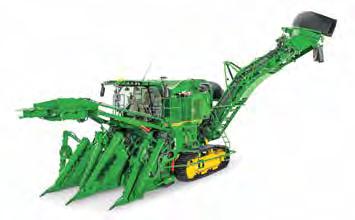
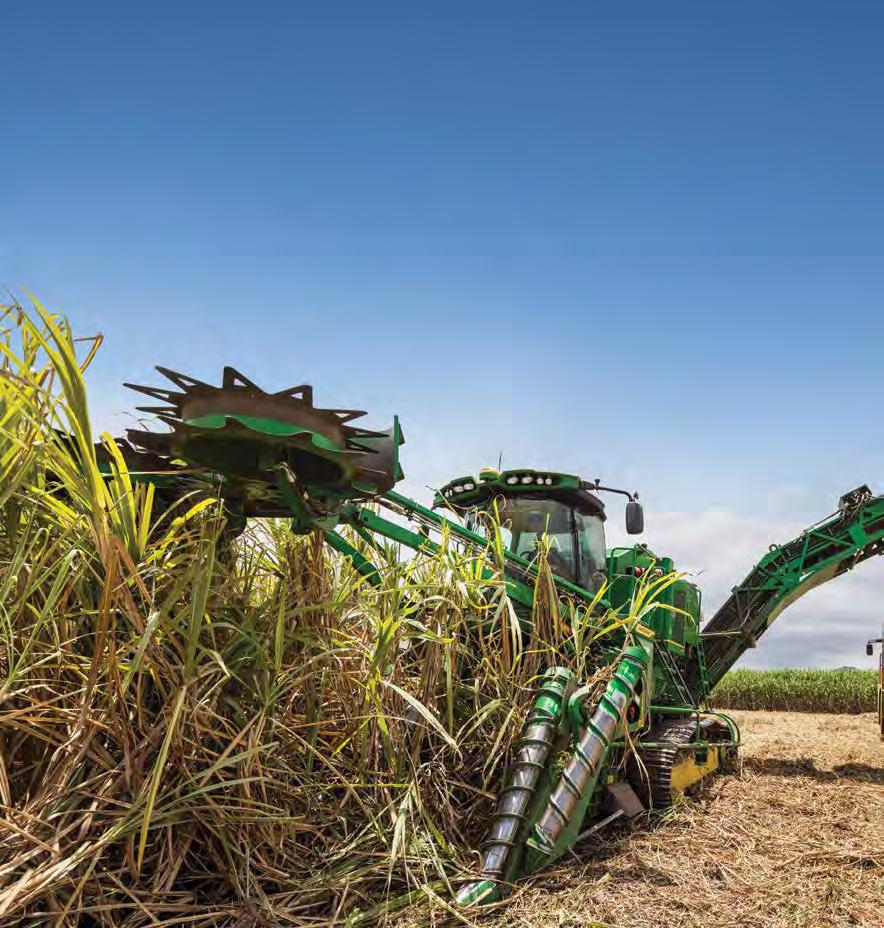
Maryborough Mill could soon make history as Australia's firstever decommissioned mill to be resurrected.
2022 season could potentially be great, but growers are anxious about the months ahead.
Brooke Robke has returned to her roots, giving up the beauty parlour for a life in the paddocks.
Point growers face an uncertain future, with their mill failing to fire up four months into the 2022 crush.
IMAGE: CANEGROWERS
Greg Zipf
cope
crop.
the

Point
worried about growers'
crush this
COVID-19 lockdowns
beautician Brooke Robke on the road to a life in farming.
more

The Federal Government's new climate laws could be good news for Queensland's sugar industry, with reports the European Union (EU) is ready to sign a Free Trade Agreement with Australia, providing new access for a range of commodities including sugar.
The EU, which has introduced its own strict climate laws, had been reluctant to commit to a FTA with Australia under what it deemed as the previous government's inadequate emissions reductions targets.
"Australia has now good climate targets, the new legislation passed ... is quite similar to the European Union, and now it’s really important to agree on some concrete projects," chair of the European Parliament Committee on International Trade, Bernd Lange told The Age newspaper.
"We are here to push for a new trade agreement, and the push is necessary because we want to have a conclusion at latest [by] February next year."
However, while welcoming the EU's newfound enthusiasm, Federal Trade Minister Don Farrell suggested there was still much to negotiate, saying the government would only agree to a deal that included "substantial" new access for commodities, including sugar.
"‘We are very keen to advance our agricultural interests to make sure that we get a fair deal for our farmers in Europe," Minister Farrell said.
The sheer size of the European market and the demand for sustainably produced goods could be an opportunity for the Queensland sugar industry, CANEGROWERS Chairman Owen Menkens said.
" We export over 85% of our sugar, so gaining access to any market is very important," Mr Menkens said. "And with a high-income economy of over 450 million people, the EU has potential to be a lucrative market indeed."
Mr Menkens said the EU was determined to include only sustainably produced agricultural products in any trade deal.
"CANEGROWERS is focused on ensuring our industry-driven Smartcane BMP accreditation meets the EU's sustainability criteria.
"Distance will always be an impediment to Australian sugar exports to Europe. However, by ensuring we offer a reliable supply of top quality, sustainably-produced sugar, we will have an advantage over our competitors and will hopefully be able to extract a premium for whatever sugar we do export to the EU", Mr Menkens said.
Read more on page 14.
We export over 85% of our sugar ... with a highincome economy of over 450 million people, the EU has potential to be a lucrative market."
The National Farmers' Federation has welcomed the Federal Government's plans to stockpile Diesel Exhaust Fluid (DEF), also knows as AdBlue, while also building Australia’s manufacturing capacity to ensure the resilience of the trucking and farming industries.
AdBlue is critical to the operation of diesel vehicles, lowering noxious emissions which are harmful to people and the environment.
The government announced a $49.5 million investment over four years to establish an emergency stockpile of Technical Grade Urea, the critical component of DEF.
It will also support sovereign manufacturing capability and increase market transparency, Minister for Climate Change and Energy Chris Bowen said.
“While the market is currently well-supplied, we need to put in place measures to deliver certainty and provide back-up in case of disruption," Minister Bowen said.
“We are also monitoring and engaging with industry to ensure the market is functioning properly and the supply chains are delivering.”
NFF Vice President David Jochinke welcomed the announcement.
"Moves to secure AdBlue supplies past the end of this year will come as a relief to farmers," he said.
"AdBlue is critical to keeping our farm sector moving. Without AdBlue, modern tractors, trucks and utes simply stop moving, and our supply chain grinds to a halt.
"Last year we came uncomfortably close to a full-scale crisis, when the Government stepped in to extend production.
"As that stopgap comes to an end this year, we’ve been calling for longer term measures to secure Australia’s supply."

Maryborough Mill could soon make history as the first ever shuttered Queensland sugar mill to reopen, with an agreement to sell the mill almost a done deal.
When MSF mothballed the mill in 2020 it brought down the curtain on 126 years of cane crushing in the region, but an agreement between MSF and Australian-Japanese joint venture, Advanced Energy Group, could see cane going through the rollers as early as 2023.
"It's not a done deal just yet, there are still some things to be finalised, so we don't want to start celebrating," CANEGROWERS Maryborough Chairman Roger Bambling said.
"But everyone is very happy and very excited at the prospect of the mill reopening. If you'd said 18 months ago that this was going to happen they would have sent you away in a straitjacket.
"If it all goes through as we hope, it will be the first time a mill that has been closed has started producing sugar again. I think it will be a great thing, not just for the industry here in Maryborough, but for the industry as a whole."
As part of the deal, the mill must be operational and ready to crush cane when MSF hand over the keys.
Jeff Atkinson , who is working on the project for CANEGROWERS, said equipment had started turning up at the mill.
"Some pumps have been delivered to the mill and job ads have gone online to recruit workers to get it up and running," Jeff said.
"There is still some paperwork to finalise, but my understanding is the deal is 99% done. Still, that 1% can always cause you problems."
If all goes to plan the mill will start crushing cane again in the 2023 season, Jeff said.
"For the first two years at least the mill will produce sugar as usual, but the new owners have a plan in place to produce ethanol and renewable diesel. It's an exciting time for the local industry. We just need to get it over the line."
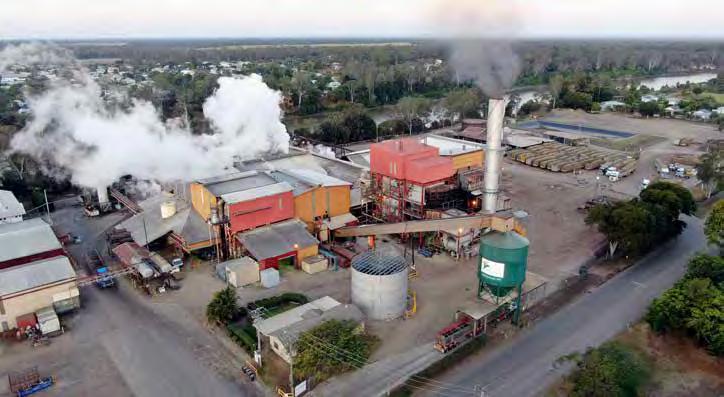

With a large healthy crop and sky-high sugar prices, 2022 has the potential to be a bumper year for Queensland's sugar industry. But as the 2022 cane crush passes the midway mark, growers are anxiously eyeing the horizon for rain clouds that threaten to derail the season.
Despite getting off to a rocky start due to widespread rain events, and the ongoing issues with mill reliability and workforce shortages, harvesting crews have delivered over 50% of Queensland's sugarcane crop to the state's 19 mills.
However, the Bureau of Meteorology's recent declaration that a third straight La Niña event is now underway, has growers worried that the already delayed crush might be further disrupted, with cane left in the paddock a real possibility.
Rachel Davis , the Horticulture, Sugar and Wine Lead at BOM said communities and industries across eastern Australia should be prepared for wetter than average season.
“This is not just due to La Niña, there are a lot of other climate drivers and factors adding to this event,” Ms Davis said.
“The wetter outlook is also influenced by warmer waters around Australia which favour more evaporation and cloud coverage in our region, and this has shaped the outlook for the weather ahead, where we do have a wetter than average spring and early summer forecasted.”
Wet weather is just one area of concern in what has been an unusually disrupted season for Queensland's cane harvest, CANEGROWERS Chairman Owen Menkens said.
“It’s been a tough year for the crush due to wet weather at the start and there has been a lot of mill performance issues up and down the state," Mr Menkens said.
"Nearly every area is looking at a December finish, with some areas possibly working into January.
“Once you get into that period it tends to be wetter with more chance of rainfall at that end. There is a genuine worry that growers may have some standover and that creates some concern.
“We’ll obviously be working as hard as we can with the districts and the mills to get the cane off as quick as we can."
The prospect of standover cane is particularly worrying for growers who have forward priced sugar.
Most growers will recall 2010, when the early onset of the wet season resulted in growers being unable to deliver the cane required to cover forward price sugar, at a cost of over $100 million to the industry.

QSL CEO Greg Beashel said weather risks are top of mind particularly this year with growers, and with some delays in every region and forecast for more wet weather, it’s something the QSL team are watching closely.
“Putting myself in the shoes of the growers at this time, I know I can’t become complacent about how many tonnes I’m going to deliver. I need to keep an eye on what tonnes I am going to
produce and how that might have been affected by weather or the crops a bit different to what I first predicted and compare that to the tonnage that has been priced,” Mr Beashel said.
“You are better off putting your hand up early to seek advice because the more time you have the more tools that are available to manage the problem.
“Start talking about it early, QSL has people on the ground to help with a range of solutions, the sooner you get onto it the better.”
While all districts are experiencing some delay, Rocky Point is undoubtedly the worst effected. The mill, originally scheduled to start crushing in June, has so far failed to fire up.
Read more about Rocky Point on page 24.
"You are better off putting your hand up early to seek advice because the more time you have the more tools that are available to manage the problem."

We spend a lot of time in agricultural markets looking at what we call "the fundamentals" to determine what prices will do and the corresponding market impacts.
The most basic of these fundamentals is supply and demand. While there are multiple other influences on the price of sugar, this driver is clearly the biggest indicator of performance in the sugar market.
If you ever have the chance to discuss the market drivers with an expert in the field, a marketer or a trader, their insight into the amount of data and analysis that goes into what can end up being decisions worth millions of dollars is mind-boggling.
Of course, it seems sensible that we place so much weight in such an important topic. However, our dynamic industry is always teaching us new lessons. One of the key messages out of the 2022 season is that high prices only matter if you can successfully harvest and crush your crop, and for this you need an appropriate
What we’ve learnt in recent months is that we lack the capacity to forecast, plan for and adapt to our changing workforce needs.
Amongst the many factors hampering our progress through this season is a desperate lack of critical workers in harvesting, transport, milling and, in some cases, terminal operations. These people, who for years have helped keep our industry running, are now either hard to find or have decided to make alternative work
It has been a savage wake up call. But we are not alone. Through our work with the Queensland Farmers’ Federation and the National Farmers’ Federation we know that worker shortages are affecting every single agricultural industry across the nation.
CANEGROWERS worked hard prior to the season to attract workers to the districts through a nationwide promotional campaign. It has had some success and has shown what will need to be done for a number of years to come.
It would seem that in an exceedingly tight labour market, and on the back of a couple of very difficult years, some workers who have invested decades working in our harvest season have now moved on.
We must work as an industry to demonstrate the enormous opportunities in both seasonal and long-term careers, building diverse roles across our supply
We will need to attract new and greater numbers of workers to the industry, particularly in the trucking and harvesting areas, and to do that we must improve our understanding of the needs of these businesses that support our farming
How many workers, with what skills, in what locations, and at what times?
CANEGROWERS will be working with our districts to do better at forecasting this demand and therefore influencing the range of government programs that are being targeted towards this challenge.
We already have a seat at the table with state and federal agencies who are seeking this knowledge from us and we are determined to work with government to direct their financial and policy investment to the priority needs of our industry, for this and the many seasons to come.
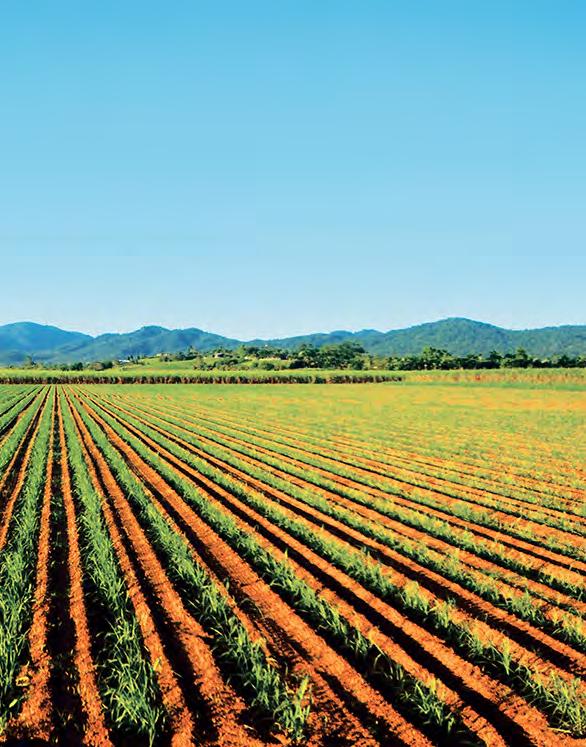
cover
cover
members automatically have access to crop
policy
Theft from farms in regional Queensland is becoming all too common, so it is timely to consider the following.
Some of the most common items stolen are fuel, especially where large quantities are stored, tools, and field equipment.
A fundamental element of rural crime is opportunity, and thieves are seeking opportunities to steal without being seen, without taking much time and without making much noise.
Farms are ideal targets for theft due to the relative isolation of each operation.
In recent years, farm security cameras have become very popular and most cameras that run on battery or solar power are capable of capturing still images or video with a range of 10-20 metres, depending on the size of the object.
Some models are equipped with infra-red, enabling images to be captured in complete darkness.
Cameras can be triggered by motion (humans, cars, wildlife) or set up to record still images over time. Most models are
wireless and weather proof, making installation and relocation quick and easy.
Another way to protect your farm and equipment is by taking out the appropriate insurance.
Most insurance is usually cost effective when compared to the replacement value of stolen goods, if you already have farm insurance, check that the sum insured is adequate for the replacement value of the goods.
If you are unfortunate enough to be a victim of crime, regardless of size, you should report it immediately to police and provide accurate and detailed information.
Actions undertaken directly after a theft will impact on the solving of the crime and possibly help solve others.
Consider these ideas to help avoid the loss and inconvenience associated with theft from farms:
• G o around the farm and look at it through the eyes of a thief and remove or lock up any items you identify as being at risk.
• Be seen around your farm often and vary your routines where possible so people can’t easily anticipate when you will be home or in the shed.
• Construct sturdy, secure sheds with high-quality locks. Tools, equipment, chemicals and other valuables should be stored inside. Use strong chains and locks on all gates, access points and loading ramps.
• M ark, engrave or stamp tools and equipment with a permanent identification number and keep a record of all tools and equipment.

• O bserve and record suspicious behaviour and note down descriptions of strangers and vehicles including number plates, location, date and time. This can be helpful to police if crimes occur in your area.
• Install security lighting around sheds, storage facilities and equipment with lights operating on time switches or sensors.
• Lock fuel storage tanks and make sure they can easily be seen from the house. Have lockable fuel caps on all tractors and vehicles. Park machinery close to home if possible or if necessary, park it where it can be seen from a neighbour’s house. Remove keys and lock the cab on machinery when not in use. Consider disabling machinery and don’t leave valuable tools in vehicle trays.
• Consider using animals as deterrents. A good watch dog with proper signage such as “Beware of Dog” is effective.
• Keep photographs or video records of your property and equipment in case of theft.
• Always notify the police of crime. No theft is too small to report.
Cane growers supplying the Mossman Mill are taking to the road in a bid to get their season back on track, carting their own cane to the factory as a shortage of truck drivers threatens to derail their 2022 crush.
Far Northern Milling Chairwoman Maryanne Salvetti said growers in the region with MR or HC licences would start driving cane trucks in a bid to maintain supply to the mill.

"Not many growers have got B-double licences but we're going to run singles, so semis," Mrs Salvetti told ABC Radio.
"So instead of moving three bins down to the coast, we'll do two, but it will give them more of an opportunity to get three trips in the 12 hours, because it's not as long a haul if you haven't got a third trailer on. The length is the same, but it's not as hard to get two bins down as it is to get three down.
"We've got a number of growers with HC licences and so we're just working through who can spare some time out of their farming operation and how many shifts they can do through the week. They'll be 12 hour shifts and it'll be every day, of course, but it'll just depend on how much time the growers can spend in the trucks."
Mrs Salvetti said growers had been very supportive of the idea and were willing to take time away from their farming operations if it meant getting the crop in.
"110% support. This is a cooperative mill. We all own the mill. We all understand the difficulties that not only Mossman but
the whole country, the whole world is facing with a lack of truck drivers, in fact a lack of any skilled people across the board.
"The growers would rather not be driving trucks. And you know, as chair of Far Northern Milling, I'm not really terribly excited about the growers driving the trucks, but we all understand that we're in this together and if we're going to get this crop in, we've all got to do our bit."
While Mossman is the hardest hit by the truck driver shortage, a lack of truck and haulout drivers is delaying harvesting operations right across the industry.
Queensland Trucking Association CEO Gary McMahon said there was no quick fix to the shortage with truck drivers wanted to fill more than 2,000 vacancies across Queensland.
"It's been an ever increasing problem over some years now. Doesn't matter which state you're in, which part of the state, which industry you're working in, the shortages are right across the board," he said.
"We've been lobbying hard with the government to get truck driving recognised as a skill up to level three, so that we can also consider skilled migration."

There has been a lot of discussion recently about a free trade agreement between the European Union (EU) and Australia.
We export over 85% of our sugar, so gaining access to any market is very important. And with a high-income economy of over 450 million people, the EU has potential to be a lucrative market indeed.
The EU is a net importer of sugar due to its declining sugar beet crop over the last few years.
This decline is largely due to the restrictions placed on chemical use by the EU Commission, which have negatively impacted the yields of many EU growers.
Sugar beet is a fast-growing broadleaf plant that requires the use of insecticides and fungicides. By restricting the use of certain chemicals, the Commission is hindering sugar production.
This decline is unlikely to be halted any time soon, with the EU requiring that 25% of all farmlands be organic by 2030.
The demand for sugar in Europe does mean that there will be a market for our industry in the future, as long as there are commercial and meaningful volumes included in any free trade agreement.
The EU wants to include only sustainable agricultural products in its trade deal, so CANEGROWERS is working hard to ensure that our Smartcane BMP program is recognised as achieving Europe's sustainability benchmarks.
The economics of shipping Australian sugar to Europe may mean it is never a huge market for us. However, if we can extract a premium for our high quality, sustainable and reliable supply, then anything is possible if the demand is there.
CANEGROWERS delivers industry trade strategy as a joint initiative with the Australian Sugar Milling Council. We were successful in obtaining federal government support for major implementation components of the strategy.
Together we involve QSL and all sugar marketers under an industry trade committee to ensure that as an industry we are focused on positioning Australian sugar in as many markets as possible at the most commercially viable terms.
But our trade priorities go further than sustainability issues, extending into pursuing alternative markets and seeking a final result from our win against Indian export subsidies. While implementing trade strategy takes a whole of industry approach, trade policy is a large part of what CANEGROWERS does, as we are convinced that grower-needs must be front and centre when seeking better outcomes from all of our market access opportunities. ■



It's fair to say that these recent years of pandemic have taught a great many people a great many things, but for Mount Martin woman Brooke Robke, the time has shown her that her true vocation is the farming life.
Brooke, aged 20, said that she had been working as a beautician, in which she had achieved her trade postschool, but COVID-19 lockdown layoffs had meant she was spending her time on the farm.
"I wasn't going to sit around doing nothing for two months, so I started to work here. It was in that time, when I went back to work, that I realised that I wanted to wake up to this every day, that I didn't like town very much," Brooke smiles, gesturing out to the rolling pasture and caneblocks in the valley country around the family Queenslander.
She started working full-time on the farm in March last year.
"I've obviously grown up with a strong family connection to agriculture - a lot of our family have been involved in different parts of agriculture," Brooke said. "I just love the lifestyle of it."
For six generations, her family has farmed in the beautiful Mount Martin area, from the first-generation horticulture of German immigrant Gottfried Dahms, transitioning across the generations through to the cane and Grey Brahman stud operation led by her father Darryl today.
Darryl said it was good to have Brooke working on the farm.
"I had the opportunity to work with my father every day of my life, and I think maybe Brooke wanted to have a crack at that too," he said. "Because not many people get to do that."
Brooke agreed: "I think seeing the relationship that my Dad and grandfather had, I've always aspired to have that relationship with my Dad."
Darryl said he was enjoying teaching her more about the business and the craft of growing cane.
Brooke said "It's good everyday when we drive around, we'll drive past something and Dad will start giving you a bit of info on this, and why we do that."
She said her family had operated the property continuously across those 141 years. This had been part of her inspiration to take on farming.
"Because we've been here for so long, all those roots are here: it's important to me to continue it, and hopefully more generations can take it on," Brooke said. "It's just in my blood, I think, and I don't know any different! I just feel so strongly about it, and want it to keep going."
"I hope a lot of other young people in ag feel the same way. There is quite a large group of us, I just hope it doesn't fade away, I hope we can keep it [agriculture] going. Because it really is up to us now. When all of our parents age, there is going to need to be another generation to keep the boat floating."
She's embraced the work of the family's sizeable operation whole-heartedly, taking on everything from maintenance of every machine in the shed to recordkeeping for spraying to working with the cattle.
"Most of the machinery here I can operate with a strong degree of confidence. Just because I am a young female doesn't mean I can't do anything that men can do," she says determinedly.
"My great-great-great grandfather Gottfried Dahms settled here in
and is buried on the farm."
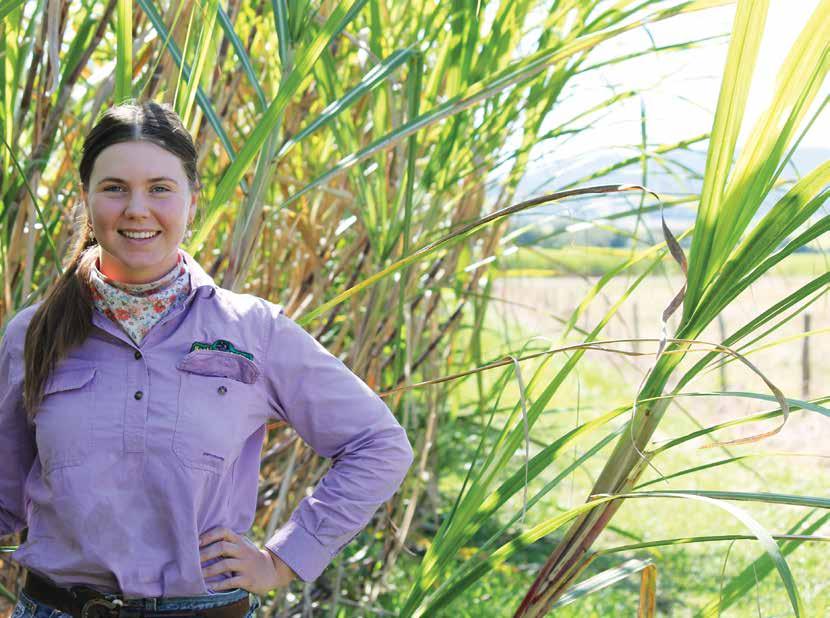
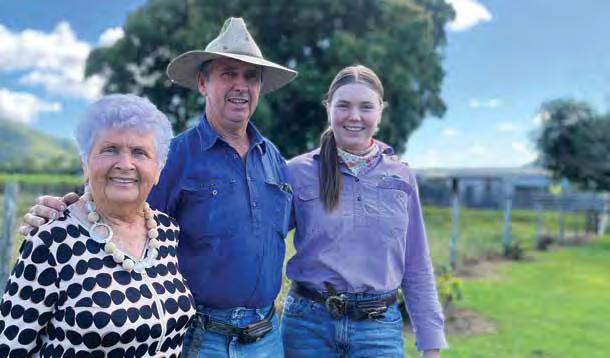
Brooke said she found the mixture of cattle and cane equally interesting.
"When you have dual parts of agriculture, you have to know how to do both of them: you've got to pay attention and take notes on both sides."
It's what she has grown up with.
"When you've grown up in an environment like this, it's just normal. When I was little it was normal to go irrigating with Dad and Grandad at nine o'clock at night: it's just a fun thing you do," Brooke laughs.
"Growing up with it" means that she fully acknowledges that farming is rewarding but that the work is always there, no matter how you feel.
"It's a lifestyle I enjoy, but I understand as well it's not that you wake up one day and feel like doing this. If it needs doing, you've got to do it or things are going to go pear-shaped.
"But that's also challenging about cattle and cane. A lot of farmers that just have cane, have all their issues, and the machinery that they have to fix, but we have that plus another whole industry and its issues. But at least cane stays where it is and can't break fences!"
Actively working the farm is teaching Brooke much about the finer details of the elements she has to work with, from the way black soil behaves, to the waiting game that recent rains have imposed upon planting time.
Brooke went to school in Mirani, but agriculture was not an option for education there. All her learning has been hands-on with her family.
"It was odd, there was no opportunity for that. There was opportunity for all your trades and that sort of stuff, but nothing with agriculture at all," she said.
"I think nowadays, a lot of kids are so pushed to know what they want to do, that if agriculture is not an option, if they can't study it at school, kids that don't have the privilege of being in a family that farms, can't understand what is involved and what it is about- obviously they are not going to leave school and see it as an option, and will lean more towards other areas."
Most people she went to school with were not headed towards agriculture, although she thought some of the boys first focused on getting a trade then would head back to agriculture.
Now that she is out of school, she is starting to connect more with other young people in farming. Recognising the importance of networks, she said she was starting to look towards some of the Young Farmers groups emerging in Mackay-Whitsunday, and may connect with one of them.
Brooke thinks it's important for there to be role models in ag: whether it's other young people taking up the reins, or women in the industry.

"Kids that don't have the privilege of being in a family that farms, can't understand what is involved ... obviously they are not going to leave school and see it as an option"
"In my father's generation, there are a few lady role models that are amazing to look up to," she said.
The difficulty of attracting people to stay in ag - or to shift to agriculture as a career was a sign of the times, Brooke thought.
"I think it has the label as a hard sort of job, and in today's society, everyone is gradually getting lazier. For kids growing up, I think it so much easier for people to get a seven on-seven off roster at the mines, and go and get money. But they don't do anything for seven days, and I think that's what they like about it.
"No-one has the willpower or the drive to commit to farming, because it is a lifestyle and a commitment, it's not just a job, you start when you've got to start, and you leave when the job is done."
Brooke has also observed how certain current realities of the sugar industry are impacting enthusiasm.
"As someone new to the industry, I can also understand the frustration for the farmers at the moment with the poor milling capability of local mills. I know they are trying to fix it, but there's so many people that don't have hope.
"More and more people are getting out of farming, and it's sad. It used to be such a glowing industry, everyone used to farm, and now you see fences going up and paddocks getting ploughed out.
"So, it would be good to get more young members getting into farming Australia-wide to keep it afloat."

She felt the positives outweighed the negatives when it came to agriculture.
"There's so many different kinds of work involved with it. There is so much to learn: you never stop learning with it, and there's so many different pathways you can go down," Brooke said.
"You don't even have to be out in a paddock to be in farming: you can be someone in a lab, you can be an agronomist.
"Australia can't continue without farming. And being one of the farmers, it's nice to know you are a part of how the world's going round. It's us, we are the reason there is food on the shelves." ■
Pictured opposite: Brooke is proud of her family heritage on the property.

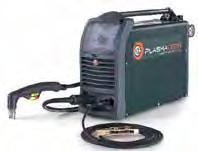
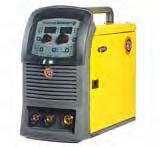
Fe40+ will also weld over old T/C chip. Great app for base cutting discs.
Easily applied with a standard MIG machine.

$750
GST. 1.6mm
5kg SP.

CANEGROWERS Cairns Region visited St Rita’s School in Babinda in September to share the story of growing sugar with primary school students.

The visit started in the classroom where the students were taken through the basics of growing cane, to harvesting and milling and to the production of raw sugar.
Samples in large jars allowed the students to touch and feel prepared cane, juice, molasses, mill mud, bagasse and raw sugar.
The students along with their teachers then travelled to the Ghidella Family Farm where they learnt more about the sugarcane plant and all the work that goes into growing a sugarcane crop.
Students all had a go at planting a billet of cane under the watchful eye of Stephen Calcagno and Lance Rodman

The harvester and tippers proved interesting with these youngsters never having been in close proximity before.
CANEGROWERS Cairns Region sees engagement with schools as well worth the effort.
Although the organisation has previously been focused on older students through to job seekers, this outing provided a great opportunity to demonstrate to the students and particularly the teachers the great work that sugarcane growers do to reduce our environmental footprint. ■
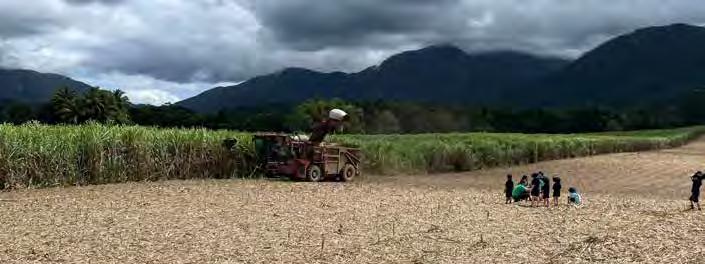
Pictured left: CANEGROWERS Cairns Chairman Stephen Calcagno explains the growing process to students from St Rita's School during a recent farm visit.


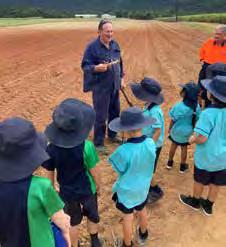



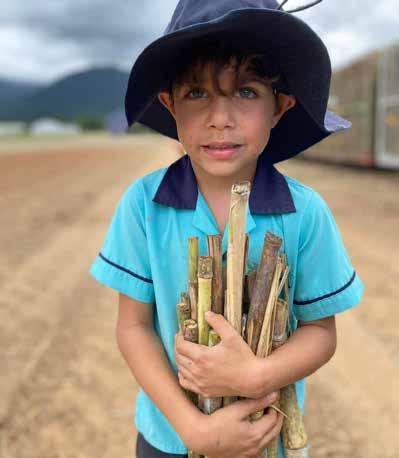
As we all know, weeds, pests and diseases have the potential to greatly reduce sugarcane yields. In recent years, the industry has evolved a robust set of control options to minimise their impact.
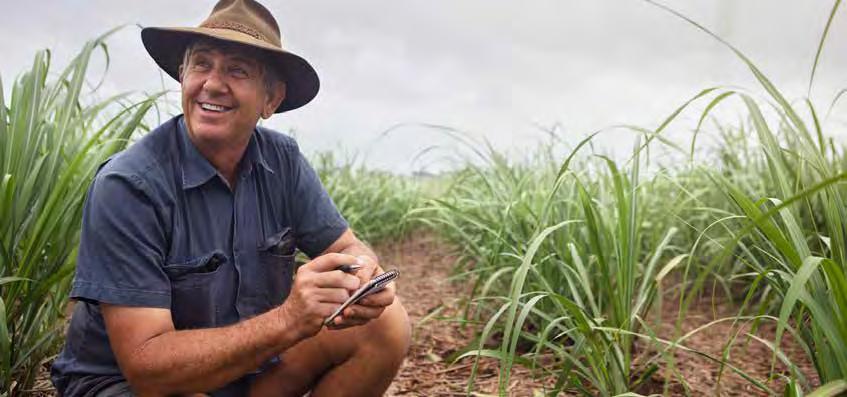
However, there are still challenges and opportunities. For example, there are legal constraints on the use of some products, and each year there are new products on the market to consider.
There are also opportunities to achieve effective weed control with less use of residuals and more precise application technologies.
Avoiding diseases relies on accessing disease-free seed, using resistant varieties, and implementing hygiene practices to reduce spread by machinery. There are now testing methods for most diseases which can help prioritise and target interventions.
Canegrubs are the most common pest of sugarcane but other pests can be locally important, such as soldier fly and wireworms.
Weeds, pests and diseases still cause significant reductions in cane yields. It’s important to remain attentive to signs of weeds, pests and diseases to continue being productive.
It’s essential to use herbicides and pesticides responsibly so you have ongoing access to them, and to secure your reputation as a steward of the land.
Selecting products, following their labels and any regulations, and timing and method of application all affect the risk of chemical run-off into waterways and other environments.
If you’d like to document or review your weed, pest and disease practices, you can access Module 3 at smartcane.com.au. The module records your current practices, and the simple checklist format helps to identify options for further improvement.
Your district facilitator or productivity officer can help you follow-up on additional information, training or expert advice.
If you’d like more information, the following resources are available for free on the SRA website, sugarresearch.com.au:
file Weed Management in Sugarcane Manual file Fact sheets on each species of canegrub and on the other major pests of sugarcane file Fact sheets on the major diseases including RSD, Pachymetra root rot, and sugarcane mosaic
Smartcane BMP has modules that cover all aspects of the cane farming business. It includes the option for becoming accredited in the farming practice modules (Modules 1, 2 and 3). Participation is entirely voluntary, and your facilitator can talk with you about what’s involved and put you in touch with local growers who are also part of the program.
Contact your district facilitator to get involved.
Controlling canegrubs by identifying different species and monitoring plant damage, soil texture, and proximity to known adult feeding sites
Avoiding the build-up of rats, implementing a baiting program when required and maintaining the correct records
Knowing when pests are present and implementing management plans when needed
Developing and implementing a weed management plan; developing separate strategies for fallow, plant cane and ratoons; reducing the residual herbicides through banding and knock-down in inter-rows; and selecting spray equipment to suit crop stage
Avoiding diseases by implementing strategies while planning the farm and operations, destroying all cane at the end of each crop cycle, and being aware of regional disease risks and testing when needed

Select approved products, use them as per label, and be aware of the risks
Ensuring everyone who uses chemicals on your farm has been suitably trained; is storing chemicals in line with regulations; mixing chemicals at locations that meet label requirements and legislations; and disposing of chemicals and drums through approved disposal systems
Applying chemicals in line with label requirements and legislation, keeping records of chemical management for each field, selecting appropriate nozzles, calibrating equipment at the start of each season, and with each change in product, including a chemical management plan within the weed management plan, and timing chemical application to minimise run-off
Using a district-wide monitoring program and developing a unique grub management plan by applying an individual block risk assessment framework including paddock history
Participating in a district-wide monitoring program
Completing risk assessments for specific pests and implementing a management program when needed
Developing and implementing a weed management plan that focuses on controlling weeds during the fallow period, minimal use of residual herbicides, and using GPS technology to identify and manage weed problem areas
Preparing a disease survey that is updated each season, and selecting rotational crops based on their susceptibility to host known pathogens like lesion and root knot nematodes
The pesticide selection tool is used to further reduce environmental risk.
Those who use chemicals maintain their currency through relevant training
Reducing residual herbicides by banding residuals along the drill, using knock-downs in the inter-row, using automatic flow rate controllers and precision application equipment, and continuous monitoring and calibration
The percentage of harvested cane used for sugar production rather than ethanol production has risen to 45.20%, but the harvest is still lagging behind last season. To date, 366 million tonnes of cane have been harvested and 21.7 million tonnes of sugar produced for the 2022 Season.
The monsoon is expected to begin its retreat after delivering above-average rainfall to most of India (bar Uttar Pradesh). An export allowance of approximately 5 million tonnes is expected to be announced by the Indian Government shortly.
Rainfall in September, which is traditionally the wettest month of the year, is progressing well and providing optimal growing conditions for 2022/23 Season sugarcane.
Speculators are holding a very small position of 5,000 lots net short, indicating they are not overly bullish or bearish towards sugar prices. Neutral
Currency
Concerns over high inflation and interest rate hikes in the United States continue to drive the Australian Dollar lower, recently depreciating to as low as 65.74 US cents.

The outlook ratings above are in relation to AUD/tonne sugar prices. A bullish outlook is considered positive. A bearish outlook is considered negative.
Disclaimer: This report contains information of a general or summary nature and is based on information available to QSL from many sources. While all care is taken in the preparation of this report, the reliability, accuracy or completeness of the information provided in the document is not guaranteed. The update on marketing and pricing activity does not constitute financial or investment advice. You should seek
The highest grower-managed pricing levels achieved

of 23 September 2022 (all gross price actual/tonne) are:
2022 Target Price = $630 / IFC $635 (Mar23)
Target Price = $585 / IFC $595 (Jul23)
Target Price = $555 / IFC $560 (Jul24)
Target Price = $540 / IFC $545 (Jul25)
adjustment: Any 2022-Season Target Price Contract tonnage which was not priced by 20 September has now been rolled forward and an additional adjustment of +$5.24/ tonne has been applied. This means the total 2022-Season Target Price Contract adjustment is now -$0.57/tonne July roll plus the +$5.24/tonne October roll, for a total adjustment of +$4.67/tonne gross actual. As a result, unfilled 2022-Season Target Price Contract orders must now only reach their target less $4.67 in order to be filled.
Early-start and multi-season AMPs: Nominations are now being accepted for the following QSL-managed pools:
• 2023 Early-Start Actively Managed Pool
• 2024 2-Season Actively Managed Pool
• 2025 3-Season Actively Managed Pool
Nominations close 31 October 2022 and can be submitted via your QSL Direct account or through your usual pool nomination paperwork in the MSF and Tully milling districts. Marketing Deadline: GEI Sugar Marketer nominations for the 2023 Season close on 31 October 2022. See your local QSL team for details of how to choose QSL for 2023.
Traditionally, the timing of the Brazilian sugar cane harvest causes the October ICE 11 futures contract to be lower than the March contract.
The major cane-producing region of Centre South (CS) Brazil is typically at the peak of its harvesting in July-September each year, and due to a lack of storage, exports high volumes of sugar onto the world market at the time of the October futures expiry.
When the following ICE 11 contract, March, then comes into expiry in the new year, a large portion of the CS Brazil sugar supply has already been exported. This reduced supply generally sees prompt March ICE 11 contract prices squeezed higher than October contract values. The shape of the futures curve in this scenario is known as a market in carry (i.e. the closest contract is lower than the furthest contract).
However, this year droughts in CS Brazil caused a very slow start to the crushing season and mills favoured ethanol production over sugar. As a result, far less sugar than usual has been available for export against the October contract. The smaller export supply has driven the October 2022 ICE 11 contract higher than the March 2023 contract, and up to highs of 20.32 USc/lb. This is known as an inverted market (i.e. the closest contract is higher than the furthest contract).
In Queensland’s most southern cane growing region, nestled between Brisbane and the Gold Coast, paddocks of sugarcane sway in the sunshine. But behind this idyllic scene there is a growing sense of fear and frustration, as the district’s cane farmers anxiously eye the Rocky Point Mill, hoping for signs of life from the still dormant steam stack.
This time last year the district had crushed 30% of its sugarcane. But almost four months into the 2022 harvest, growers are still wondering when, or if, the mill might fire up.
Initially scheduled to start crushing mid-June, a series of problems with commissioning the mill and co-generation plant, coupled with workforce shortages, have seen this date pushed back time and time again.
Growers were recently given a 21 September start date, however, as with previously proposed start dates, the day came and went without a single harvester firing up.
CANEGROWERS Rocky Point Chairman Greg Zipf said the overall feeling of the growers in the district was one of frustration and disappointment, inflamed by limited communication from the mill, privately owned by the Heck Group and established in 1878.
Last year, a combination of poor reliability with the cogeneration plant, and weather events resulted in 45% lost time and only approximately 70% of the crop crushed. This year the crop is even larger and the crushing window rapidly closing.
“The crop estimate is sitting at around 360,000 tonnes, we had a good start in the first two thirds of the season, we had wet weather and that got the crop off to a good start,” Greg said.
“At this stage the mill is telling us the crush will start on Wednesday, 5 October, that is if everything goes to plan. The cogen plant has a few milestones that it needs to achieve to get over the line.”
The cogeneration plant was obtained by the Heck Group earlier this year. While Greg believes the merging of the two separate entities will ultimately be a positive step for the district, he also recognises the challenges that were unearthed for the Heck Group with the acquisition of the plant and understands that these are some of the reasons for the delayed start to crushing.
continues page 26 ►
Pictured: CANEGROWERS Rocky Point Chairman Greg Zipf says growers in the district are frustrated and disappointed.


However, growers are frustrated with limited communication from the Rocky Point Mill and lack confidence in the mill’s reliability. Even if crushing does start on 5 October as stated, the important question remains, can the mill crush all of the district’s cane?
“We all know farming is a risky game, so you need to be able to take advantage of when you have a good crop, with good sugar and the current high global sugar price,” Greg said.
“Information is key, the more information you get, the better decisions that you can make.”
“If the mill can get all of the next year’s crop off, it’ll still take two years for our district to get into a normal farm rotation. This creates all manner of issues, importantly our cash flow is affected. And that is the hard part, when the cash flow stops it can really start to bite,” Greg said.
“Traditionally most growers in our district will plant cane from August to September, with some planting as late as October. It’s our planting window. In general, most growers in the district have got their ground ready to plant but some are struggling due to continual wet.”
With the need for cash flow to start planting, many growers are using reserves or thinking about alternative ways to generate an income in the short term. These decisions are starting to take their toll.
Having standover cane and now a limited season due to an extremely late start is impacting on the farming practices of the district, but its not just an immediate issue, the impacts will affect decisions on the farm for several years to come.
“Because we’re starting so late in the district, we’re not going to target ploughing out paddocks, we will cut blocks that hold our good ratoon cane because we want to have that cane for next year.

"If the mill can get all of the next year’s crop off, it’ll still take two years for our district to get into a normal farm rotation ... when the cash flow stops it can really start to bite"
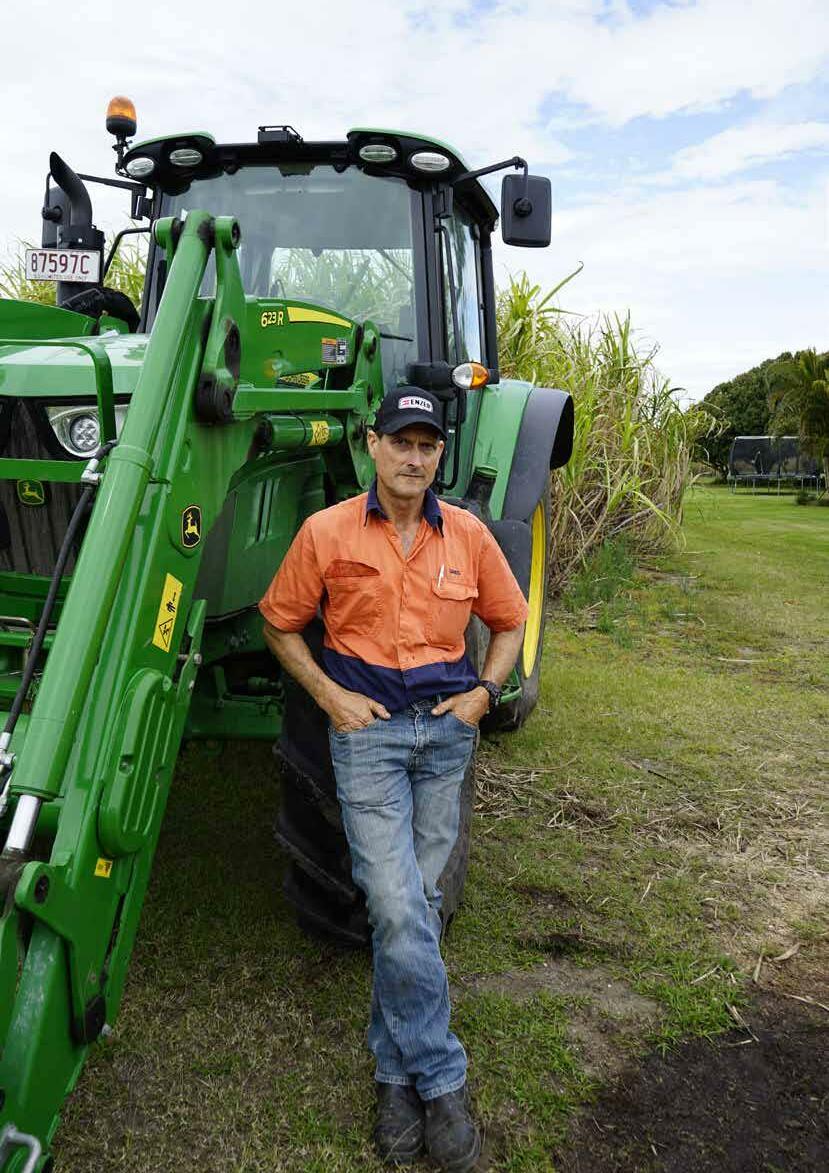
"We’ll leave our plough out to the end and realistically some of our plough out may not even get cut, because some of the plough out would have been some of the later cut cane last year, that may become standover cane.
“Potentially my cash flow for next year is going to be down,” Greg explained.
“That means bottom line, my cane tonnage is going to be down, my income from cane mulch is going to be down, and next year I’ll have less land to plant soy or crops that I can gain extra income from.
“The majority of the cane cut in December will not make a oneyear cut next year so it will become a two-year crop in 2024. Whatever is cut in January 2023 will not be ready to harvest again until the 2024 season.
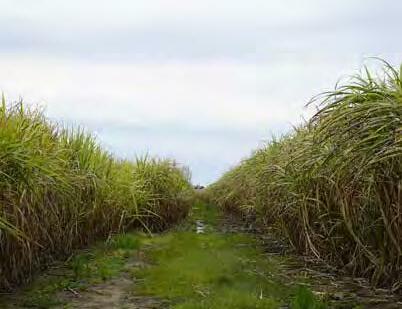
“It’s going to take two years to get into a ‘normal’ farm rotation. That’s the frustrating part.
“For example, if I only cut 60% of my cane crop, then I will not have enough cane mulch to provide to my customers and the landscape suppliers that are relying on my business to have material available all year round. The variance will be the weather and how the factory runs.”
The district has had its share of challenges over the past few years, not limited to the uncertainty of when the mill will start operations.
The extensive flooding that hit the area in March was comparable to previous catastrophic floods, in particular the 1974 floods, and at Greg’s family home at Steiglitz the water levels surrounding his house were only about 300 mm lower than in 1974.
“We won’t really know the impacts on the crop until harvest. I personally don’t think the cane is there though because the ground was too wet for too long,” Greg said. “I expect there will be an impact on the crop.”
CANEGROWERS Rocky Point is also struggling to obtain sufficient assistance from Biosecurity Queensland for an increasing problem with fire ants in the area and is currently working on an agreement for the supply of bait under a new program, the Fire Ant Suppression Taskforce (FAST).
The most appropriate and efficient way to combat the ants is by aerial treatment. However, this type of application will not be allocated to Rocky Point for a number of years, until such time as this area becomes the focus of an eradication program rather than just suppression.
“Ongoing fire ant issues continue to hinder especially where flooding appears to have increased the numbers of ants through the district and accessing sufficient and effective bait is proving challenging for everyone here.
“As the mulch industry plays a big part locally, especially for many growers’ hip pockets, fire ants are a concern. We’re determined to be proactive, as we don’t want to lose that part of our industry here.”
CANEGROWERS Rocky Point continues to provide advocacy for growers around ongoing drainage issues and constantly keeps discussions open with the relevant council authorities to maintain the existing drainage system effectively.
“We keep the pressure on the council to upgrade the exit points and keep the drainage system clear and free of debris, to open up the drainage system as much as possible so that water can get out as quickly as possible especially on the western side.
“Add up all the issues that we are up against and it can feel pretty challenging at times. You've got to put your thinking cap on to figure out how to deal with those issues and find ways to keep supporting our growers.”
Greg said that the illegally dumped tyres on CANEGROWERS
Rocky Point director Suz-Anna Burrow-Pearce’s farm (featured in the March edition of Australian Canegrower ) have finally been removed and he was appreciative of the media attention that highlighted the issues that growers often find themselves having to deal with regarding illegal entry and dumping on their farms.
Unfortunately, unlawful entry onto local farmlands remains a huge problem in the district. Whether it's deliberately, with hooning still a big concern in the area, or people mistakenly driving down incorrectly marked roads according to Google Maps. The district continues to work with Google Maps to rectify this issue.
However, Greg is buoyed on by the enthusiasm of the thirdgeneration growers in the district, a group of active young farmers keen to be part of the industry. While land valuations make it challenging for young growers to buy their own farms, there are leasing opportunities available, Greg said.
"It's inspiring to see their passion and to know that growing in the area remains viable into the future." ■
Australian Canegrower contacted the Heck Group for an update on mill operation commencement but at the time of going to print they had not responded.
"My cane tonnage is going to be down, my income from cane mulch is going to be down, and next year I’ll have less land to plant soy or crops that I can gain extra income from."
In an enormous boost in efficiency for Australian sugarcane producers, John Deere has introduced a world-leading two-row sugarcane harvester range that is 1.5 to 2 times more productive than singlerow models1 .
Launched in Brazil in 2020, and now available to order in Australia, John Deere Global Cane Business Manager Jesse Lopez, said the CH9 Series had been tested on Australian soil for the past two harvests to ensure the machine was ideally suited to local conditions.
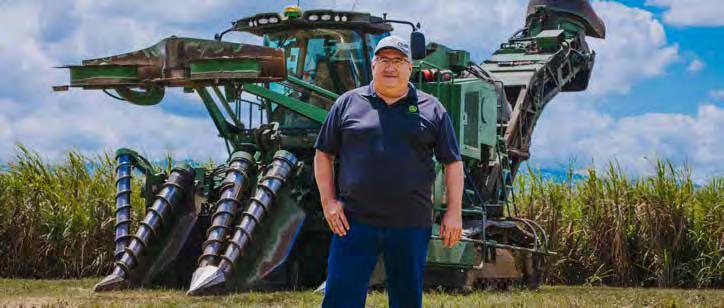
“We have worked with Australian growers over the past two harvests to receive fundamental feedback, and to prove the CH9 Series is designed to excel in the local environment,” Mr Lopez said.
“As a company, we’re committed to providing customers with machinery and technology to be the most productive, profitable and sustainable in the world, and the CH9 Series is the perfect example of John Deere innovation meeting the needs of today’s farmer.”
The CH9 Series was recognised at the AE50 Awards in 2021 for its innovative integration of two independent front feed systems and basecutters, allowing the machine to operate at a similar speed to a single-row unit, while maintaining the expected cane quality.
The CH9 Series joins the proven CH570 to provide producers with the option to order the CH950 in a 1.4 m to 1.5 m row width, and the CH960 as a 1.7 m or 1.9 m unit.
John Deere Production System Manager, Ben Kelly, said the CH9 Series was designed to support growers’ desire to achieve lower production costs per tonne, with Controlled Traffic integration – for significant benefits to soil health.
“The two-row system has proven to achieve in excess of 1.5 times more harvesting productivity1 while reducing machine hours by 33%. The CH9 Series also benefit from increased fuel efficiency, with the larger fuel tank meaning the new machines can potentially be fueled only once every 24 hours,” Mr Kelly said.
“In order to address the challenges of this increased harvest volume and uneven row height, John Deere engineers developed RowAdapt™ technology, allowing the base cutters to float independently. Cane from the two rows then merges in the machine right after the plant is cut.
“The RowAdapt system, coupled with a wider 10-blade chopper and redesigned primary and secondary extractor, reduces billet losses by up to 50%. 2 ”
The CH9 Series also features a new 13.6 L Tier 4 engine with 50% larger displacement than the CH570 9L, and uses, on average, only 82% of the maximum hp capacity.
Maintenance costs have also been reduced on the CH9 Series with new heavy-duty tracks and more wearresistant components on the elevator.
As well as increased harvesting capacity, the CH9 Series is equipped to offer industry-leading precision ag technology with the inclusion of the new Gen 4 Monitor, 4600 CommandCenter™, providing the operator with more interaction and intuitive use.
Mr Kelly said as global demand grows for more sustainable and productive food and fibre, one of the most exciting developments of the new CH9 Series is its positive impact on soil compaction.
“The rebalanced CH9 Series offers a wider base aligning the harvester's tracks directly in the centre of the rows, providing up to 60% reduction in soil compaction as the machine only travels on every second interrow,” he said.
“The reduced soil compaction and improved cut quality will also allow farmers to potentially increase the cane growth cycle from five to up to eight years.
"There are many benefits to extending the replanting cycle beyond just increased yields, including savings in input costs like planting and fuel, and the overall environmental impact of the production cycle.”
For more information, visit the John Deere website, or contact your local John Deere dealer. ■
1 During internal testing when compared to the CH570 Cane Harvester. Individual results may vary.
2During internal testing when compared to the CH570 Cane Harvester, based on tonnes per hectare. Individual results may vary.
Pictured: John Deere Global Cane Business Manager Jesse Lopez at a Tully farm where the new CH960 has been tested.
week - 13
CCS to date - 12.25
After 13 weeks of crushing (18/9) Mossman Mill had processed just over 44% of the crop, which is holding at 760,000 tonnes of cane. This means the ongoing challenges of wet weather and lack of truck drivers will continue to cause disruptions with the expected finishing date. For now, that date is late in December, but all parties are now planning for the realities of working in the industry.
On 13 September, all industry parties met to talk about plans moving forward and how to maximise all outcomes for this crushing season, with the potential for some standover a real possibility given the Bureau of Meteorology has confirmed another La Niña is underway for the third summer in a row.
At the time of writing, Mossman mill had processed 340,795 tonnes of cane for a mill average CCS of 12.25. Coastal
TABLELAND
Harvest week - 14
Tonnes to date - 340,795 (44.84%)
growers had supplied 232,803 tonnes for an average of 11.70CCS and Tableland growers had supplied a total of 107,992 tonnes for an average of 13.43CCS. With the coastal CCS being slow to improve, the next adjustment of the Deemed CCS will be in October, along with the projected QSL advance.
A number of growers attended a meeting with QSL senior staff and board members on Wednesday 14 September. They heard about the final pricing for the 2021 season, what pricing is happening for the 2022 season and how QSL has responded to the weather affected industry so far in 2022. There was also a briefing on the world market and how other countries who produce and export sugar are situated.
CCS to date - 13.67
DRIVERS NEEDED!!! The Tableland growers who supply the Mossman Mill have been advised that there will be up to 15% standover cane for this season, due to the lack of drivers. Even though the mill is performing well, there is up to 20 hours per week of lost production due to cane supply. There have been many meetings with both the Mossman Mill and the transport company to try to find a resolution to this issue.
Some of our growers are filling the seats of the trucks to try to reduce the amount of standover cane.
Tonnes to date - 320,234 (55.21%)
The Tableland Mill has an estimated finish date of 25 November 2022. The mill has been achieving an overestimate of 5%, with 113.9 tonnes of cane per ha and an average CCS of 13.69.
Growers who market through QSL and are concerned about delivering less than their estimate are reminded that QSL has a range of mechanisms available to help address the implications of an in-season crop reduction. Please contact QSL to discuss.

week -
The weather across the area has remained fine with the daytime temperatures on the rise. There is still quite a bit of planting being undertaken across the region. The ratoons are coming away nicely, while the cane for harvest is now quite dry.
Recently SRA held a Managing Waterlogged Soils Workshop in Mirriwinni, at Barry Stubbs’ farm. The event was well attended, with approximately 15 local growers participating.
As part of the workshop there was also a presentation from Aaron Davis of TropWater, which touched on topics including opportunities for catchment intervention through first flush
week -
-
Tonnes to date - 739,540 (60.13%)
retention as part of the Great Barrier Reef Foundation's Mulgrave Russell Water Quality Program, and an update on the Mulgrave Russell water quality monitoring project data to date.
Growers are reminded to get their early season bean orders in to ensure those more popular varieties are available. The direct drill bean planter is available for use by members.
Representatives from the organisation recently visited a local primary school to talk to students and teachers about the sugar industry prior to heading out on farm to observe the action around harvesting.
CCS to date -
Three weeks of favourable weather conditions has seen planting resume and the harvest pass the halfway point. Current projections still indicate that the South Johnstone factory will crush into the first week of December, including an allowance for wet weather.
Feral pigs continue to cause significant damage to our crop. CANEGROWERS Innisfail has been part of a pilot grower group implementing a landscape management approach to feral pig control.
This approach required growers to establish a coordinated free-feeding and baiting program for a 4-week period, which was then followed up with aerial culling. Growers in the group spent hundreds of hours free-feeding or baiting, checking the site morning and afternoon and collecting photographic evidence for access to 1080 baits.
In total, 180kg of 1080 bait was put out and 22 pigs shot. At the conclusion of the program, we had a visit from Dr Heather Channon , the National Feral Pig Coordinator, to talk to the grower group.
Dr Channon sympathised with the level of damage sustained to the local industry and was impressed with the amount of effort industry had invested. Dr Channon also provided valuable advice on how to improve the program moving forward.
week - 16
to date - 12.62
The Tully District passed the halfway mark for the 2022 crushing season in mid-September. However, with the estimate sitting at approximately 2,850,000 tonnes to harvest, there is still a long way to go. The average CCS is 12.66 to date, with a current mill area yield of 100 tonnes/ hectare.
Last month SRA facilitated a workshop focused on Managing Waterlogged Soils, with SRA manager Barry
Tonnes to date - 755,833 (50.22%)
Tonnes to date - 1,509,753 (52.97%)
Salter, agronomist Julian Connellan and DAF economist Caleb Connelly presenting the outcome of trials of enhanced efficiency fertiliser in the catchment of the Great Barrier Reef.
Discussions and planning have continued with industry members for the implementation of the Cassowary Coast Reef Smart Farming Project in the Tully area, feral pig aerial shooting project and RSD management.

Harvest week - 14
CCS to date - 11.94
As at 25 September, the Herbert River District had crushed over 2.5 million tonnes of cane, with a season to date CCS of approximately 12.0.
We have been receiving some favourable weather recently which is seeing the paddocks dry up and harvesters in the district get into full swing.
Although we have still see some issues with the mills which are affecting mill reliability and availability.
A number of growers from the district attended SRA’s harvesting demonstration trial utilising the latest technology at a local farm in Yuruga. This included testing the newly developed SRA DAF Harvest Mate decision support tool.
It will be interesting to review the data from the trial as this block was cutting around 140 tph.
Pictured: photos taken of SRA field workers collecting extracted trash to determine juice concentration against different harvesting practices.

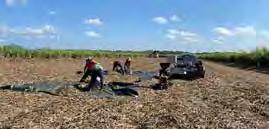
Harvest week - 14
CCS to date - 13.79
The Burdekin District reached the halfway mark in the week ending 17 September, having crushed 4.1 million tonnes out of the 8.15 million tonne crop estimate. Despite this, we remain weeks behind schedule for this time of year, due to the wet weather experienced in July. CCS season to date is 13.80 which is under budget but has been improving of late due to a run of dry weather.
A new cane transfer program commenced on 12 September, with Wilmar transferring cane from Kalamia Mill and Inkerman Mill at a rate of 60 bins/day from each mill area to be crushed at Invicta Mill. This is in addition to the cane transfer that has been occurring from Pioneer Mill to Invicta Mill. We are still looking at a season end in the Burdekin of 24 December for the last mill to finish. To improve on this we will need to experience a spell of dry weather and good mill performance which are two variables we are unable to control. Any opportunity to transfer more cane would be advantageous in helping to reduce risk and address the late season end as CBL’s policy is to see all mills in the district have an equalized finish date and we will continue to monitor this position. At this stage, Invicta Mill has been performing well and is on track to finish weeks ahead of the other mills and has the capacity to assist with cane transfer.
The CBL Board met with STL and QSL representatives about the Storage Handling Agreement (SHA) which has not been signed by QSL for a number of reasons and both parties provided an update on these issues from their perspectives. Whilst STL continues to receive, store and ship sugar, we nevertheless remain concerned that QSL, which is STL’s biggest customer, has not yet signed the SHA and we are keen to see this matter resolved as soon as possible for the benefit of the industry in terms of providing certainty.
Tonnes to date - 2,304,906 (52.38%)
Tonnes to date - 4,114,607 (52.49%)
The bulk sugar terminals are prized industry assets which were paid for by industry for the benefit of industry and we would urge the parties involved to negotiate solutions to move from stalemate to contract closure. At the end of the day, it is the grower that always pays and we need to see these assets run as efficiently as possible to keep them cost effective when servicing their customer needs.
CBL participated in a mid-season review with Burdekin Cane Audit Services (BCAS) and Wilmar. We are fortunate in the Burdekin to have such a dedicated and well-run auditing service that underpins the payment integrity of the system for the local industry. What can make the auditors job easier is the accuracy of source data and there are two areas where this can be enhanced to streamline the audit service. Growers are reminded to encourage their contractor to ensure delivery tickets are completed for every delivery’s harvest time as this assists with the proper identification of start times to get the clock ticking which is crucial in identifying affected cane under the 24-hour cut to crush rule. There are also issues this season for differences with varieties listed on delivery tickets which are not correlating to farm maps and growers are encouraged to check their farm maps and report any errors to their Logistic Officers for correction.
Members are reminded that CBL offers an inhouse service to members at no cost to assist with the completion of N&P Budgets. The feedback on this service has been positive and beneficial to members in helping them to understand what their fertiliser management requirements are from both a regulatory and farm management perspective. Should you require some assistance in this regard, please contact Mindi Lennon at our office.
Harvest week - 12
CCS to date - 13.85
Despite fine weather and ideal harvesting conditions over the past month, the Proserpine crush has been arduous and gruelling. A series of unplanned stoppages and derailments have prevented the mill from establishing any consistent throughput. In the four-week period since our last report, the mill has crushed less than 315,000 tonnes.
Consequently, a meeting was held with milling executives in mid-September to establish a way forward for the remainder of the crush. The meeting was positive and there was
Harvest week - 14
Harvest week - 14
Mackay Sugar is reporting a 10 January end to the crush, which is ominous for all growers when combined with predictions of an early onset to the wet by the Bureau of Meteorology.
Tonnes to date - 713,938 (42.00%)
optimism that the harvest could still be completed by earlyto-mid December. While this isn’t ideal, the crop continues to cut above the revised estimate of 1.70MT.
On a brighter note, CCS is slowly increasing again after the August rain event – the season-to-date average CCS currently sits at 13.85. The Collective’s interim payment CCS will be reviewed in the coming weeks to offset the potential impacts of forecast rain in Nov-Dec.
CCS to date - 12.77
CCS to date - 12.91
Tonnes to date - 2,348,719 (41.42%)
Tonnes to date - 697,780 (46.52%)
opportunity for our region to become a major player in a new, emerging economic area.
It’s a situation causing genuine angst and uncertainty for growers, with only 41% of the 5.67+ million tonne crop processed by mid-September, and both Farleigh and Marian mills experiencing breakdowns, Marian for several days. Racecourse Mill, at the time of writing, had not experienced a breakdown in September.
CANEGROWERS Mackay assures growers that we are actively working with NHVR around the issue of permits to continue heavy vehicle use through the Christmas curfew.
Storms presented over the week from 17 September, with one, including hail, impacting cane supply to Plane Creek Mill. It was an unfortunate disruption, as the mill has been pushing its highest throughput for the season, at around 69,000T for two consecutive weeks. The mill was at 46.5% of the 1.5MT crop.
We continue to urge growers to make the best they can of remaining fine weather and take every opportunity to cut. All mills across Mackay and Plane Creek milling district continue to report a rising CCS.
Plane Creek: Week 14, ending 17 September, showed weekly average CCS top 14 for the first time this season, at 14.02. Highest rakes are topping 16. The season-to-date average was 12.91. Mackay milling district is a touch lower on CCS: for week ending 18 September, the weekly average CCS was at 13.66 with a season average of 12.77.
At district office, there has been a focus on supporting growers, along with work in the sustainability and bioeconomy spaces. A bioeconomy forum was held in Mackay by Life Sciences Queensland, attended by Chairman Kevin Borg and CEO Kerry Latter. While case studies and opportunities for cane and other agricultural/aquacultural areas were presented, the key message was that our industry needed to act to make the most of a window of
Any growers requiring assistance to source harvest labour are welcome to call 07 4944 2600. Alternatively, respond to work wanted ads or post positions vacant direct to www.mackaycanegrowers.com.au/farmers-notice-board
Pictured: This month CANEGROWERS Mackay’s Billet features a story on growers Allan McLean and son Scott’s work on soil health - and particularly correcting mineral balance - with great results for yield and sustainability.
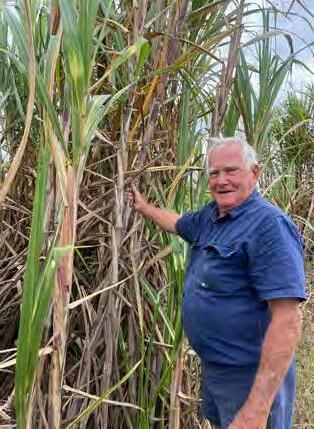
Harvest week - 14
CCS to date - 13.13
Bundaberg Sugar Mills processed 45,118.30 tonnes for the week ending 18 September, bringing the season-to-date to 498,304.62 tonnes. The average CCS for Week 14 was 14.29 CCS, with the highest individual CCS for the week being 16.30 units for Q240 Old Ratoon. The season CCS average for Bundaberg Sugar Mill is at 13.12 CCS.
The latest round of mill issues has been rectified and daily throughput has increased. If the target crush rate is reached for the remainder of the season we anticipate a grower finish date of 3 December (excluding wet weather). Transport issues have also improved, although a shortage of trucks, bins and drivers continues to cause some delays.
The spring planting window is now open with many growers already taking advantage of the increasing soil temperature.
Harvest week - 14
CCS to date - 12.91
Spring has definitely sprung across the Isis district with many growers taking advantage of the drier weather to get their spring plant in the ground whilst the sun is shining.
Our Group Harvesting Equity committee is continuing to keep a close eye on harvest equity and is meeting regularly with Isis Mill to discuss season progress and plans for getting the remainder of the crop off.
This year has been very challenging with wet weather causing significant lost harvesting time. Given the BOM has announced we are now officially in our third consecutive La Niña event, there is a growing concern we may be forced to standover some of the crop. Hopefully this will not eventuate.

Tonnes to date - 498,305 (46.55%)
With the price of sugar where it is, it is an opportunistic time to plant more cane. The Bundaberg Sugar Services Oneeye Sett program has been kept busy this season as more growers look for clean seed cane and new varieties.

With all surface water storages full, and most ground water allocations also +90%, we have great potential for the coming seasons. With good prices and high water allocations, the opportunity to grow a good crop is now.
As some of you might be aware, various insurers have recently increased their rates. Ray Goodwin is always available to review your insurance to find competitive insurers and ensure that your cover is adequate. For more information regarding insurance matters call Ray on 0418 891 783.
Tonnes to date - 367,644 (41.78%)
The CCS is slowly climbing across the district with some growers reaching in the high 15s. At this stage we are working towards a finish date before Christmas.
We welcomed the announcement of closing date extensions for lodging Disaster Assistance Recovery Grant applications for the Nov-Dec 2021 rainfall event and Ex-Tropical Cyclone Seth event to 5 December and 4 February respectively. Many of our growers have been unable to undertake reinstatement works because of the continued wet weather and high demand for contractors and these extensions will allow them the much-needed time to get the works done.
The district had falls ranging from 10mm in Maryborough to over 30mm at Sunshine Coast overnight on 22 September.
The week had been very strong for deliveries (Week 15) and will still be one of the bigger supply weeks for the season at around 27,000 tonnes delivered.
Season to date we are progressing toward 260,000 tonnes supplied by the end of Week 15. CCS has not increased much, with 13.12 units the average for Week 14.
The Queen’s Birthday Public holiday is 3 October, however this will be a normal working weekend for the mill as staff had the holiday earlier in the year.
News for the Recommissioning of Maryborough Mill has been slow in the last few weeks. MSF Sugar released Job Advertisements for staff to recommission the mill. This has since been covered in media reports.
A number of pumps were shipped back to the mill site, as the first equipment to be brought back in.
We have been expecting some news on Marketing arrangements and by the time this magazine comes out, a third group of Japanese specialists are due to visit.

The Rocky Point season start has been pushed back to the week commencing 3 October due to the Cogen repairs continuing. Weather permitting, we expect to crush well into January.
A number of growers have started planting, but there are still many paddocks too wet to plant.
We have not had as much success with our Valuation Objections this time around and are waiting to hear whether the Valuer General’s office is prepared to negotiate.
Fire ant nests in the district continue to multiply, with protracted discussions with DAF neither producing the required bait for self-management nor the Direct Nest Injection (DNI) Officers to treat the ever-increasing number of nests in the district.
We are hopeful a solution can be found soon. At the Beenleigh Show on 10 September 2022 there were six Rocky Point cane exhibitors across ten classes of cane. Congratulations to the overall winner, Geoff Rossmann .
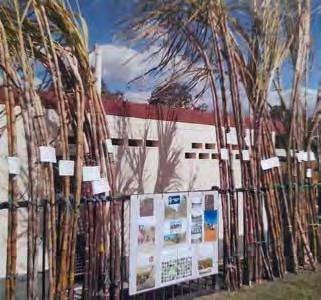
Leah and Santo Russo are relatively new to cane farming, but they are on a mission to improve farm productivity and reduce costs every year.
The Russos have several farms totalling about 120 hectares on the southern side of Ingham, around Helen’s Hill and Yuruga. Santo’s family has been growing cane in the Herbert district for generations, but for the early part of his working life, he and Leah were working jobs outside the sugar industry in Townsville.
That began to change in 2016. Santo had been working at Queensland Nickel and with its closure they moved back to Ingham, which led them back to cane farming.
In 2018, they bought about 60 hectares and they then doubled that area in 2020 with the purchase of land from Santo’s father, Frank. Contractors help with the harvesting and planting, but the Russos maintain a hectic schedule with Santo and Leah having jobs off-farm.
With the Russos being new to cane farming on their own, it created the perfect opportunity to get involved in a major project running in the district called Project CaNE™.

The project is led by Herbert Cane Productivity Services Limited (HCPSL) and is funded through the partnership between the Australian Government’s Reef Trust and the Great Barrier Reef Foundation, and supported by TropWATER and DAF Queensland.
The project provides agronomic support and tailored nutrient solutions for growers, working with them to look at soil tests, agronomic constraints to productivity, and steps to make improvements.
By partnering with TropWATER, Project CaNE™ is understanding the water quality outcomes of changed practices, while DAF Queensland are adding valuable economics information to the project.
For Leah and Santo, their interest began with an information session run by HCPSL and their Project CaNE extension agronomists.
“It was a great opportunity,” Leah explained. “One of the biggest benefits we saw was the development of a nutrient management plan (NMP), which was not something we had done before.
“The CaNE Plan told us exactly what nutrients we needed and we’ve been following that as best we can.”
The Russos said that the NMP identified opportunities to reduce fertiliser rates in some areas. Just as importantly, it identified productivity constraints.
“We saw that some paddocks needed zinc, which we have now applied,” Santo said. “The information helped us with things we wouldn’t have seen on our own.”
Under Santo’s father, Frank, some of their blocks had already been using an improvement program with mill byproducts such as mill ash, which Leah and Santo are continuing.
“The (mill) ash has been effective in breaking up the heavy clay soils,” Santo said. “We still use ash in some areas, and we are also keen to learn more about mill mud, which Project CaNE™ is helping us with.”
“We are planning to be farmers for a long time, so we want to make sure we are looking after the soil and the environment.”
assistance from Project CaNE, Santo and Leah Russo
The HCPSL Project CaNE™ team has helped establish a simple on-farm trial in an 8ha block, with 20 drills with mill mud and 20 without. The rows with mill mud were banded at under 100t/ha, with fertiliser rates reduced by 20 percent.
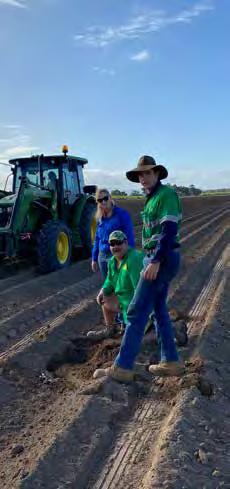
The cane was still to be cut when we caught up with them, but the Russos added that it would take a few seasons to fully understand the potential benefits.
“The trial is great, because mill mud is fairly expensive to transport, so we want to see how the crop performs with tonnage and CCS,” Leah said. “We also want to see it across a few different seasons. For example, the whole block is looking good this year as the weather has been favourable and we have planted a variety that is performing well.
“We know farmers who use mill mud religiously, but we want to see it for ourselves.”
This year will see their first crop harvested under the new fertiliser regime under the NMP developed through Project CaNE™, including reduced nutrient rates as per the NMP. Leah and Santo are hopeful that the long-
term results will combine improved productivity with greater environmental sustainability.
“The project is helping demonstrate that we are farming sustainably,” Leah said. “We are planning to be farmers for a long time, so we want to make sure we are looking after the soil and the environment.”
HCPSL Agronomist Jarrod Sartor said there had been a strong interest in mill mud among Project CaNE™ growers –and right across the district – this year.
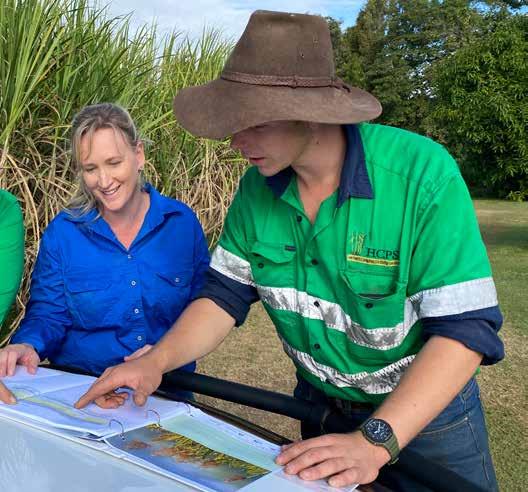
“Interest has increased with the high fertiliser price and also with the ability to band the (mill) mud rather than broadcast. That has helped with the economics of transport,” Jarrod said.
“Growers are still keen to see how (mill) mud performs and are looking at it as part of a broader soil health program. We’re seeing it being used in areas further away from the mill. As it gets more expensive, growers are targeting their poorer soils and are using it as a way of introducing carbon into the system.”
He said growers could learn more about Project CaNE™ by contacting HCPSL.

The new Federal Government has wasted no time acting on its promised climate policy reforms, quickly passing the Climate Change (Consequential Amendments) Bill 2022 to enshrine in legislation emissions reductions targets of 43% on 2005 levels by 2030.
This was immediately followed up by the appointment of an independent panel to review the integrity of Australian Carbon Credit Units (ACCUs), and a review into lowering emissions baselines in the Safeguard Mechanism framework, a move that would require country’s largest emitters to reduce their emissions further or purchase more ACCUs. The message is clear; action on climate change starts now.
Naturally there will be stronger focus on highly emissions-intensive industries like energy and transport. However, governments, markets, and communities still expect agriculture to play our part in reducing emissions.
Agriculture is among those industries that will find it hardest to reduce emissions. For the sugar industry some of the changes required will be slow and somewhat outside our control.
It will take time to implement greener manufacturing processes for fertiliser, for example, and there are no widely available substitutes for diesel farm vehicles and equipment.

However, it’s not all bad news. Analysing the sources of the sugar industry’s onfarm emissions, it’s clear that a great deal of progress has already been made. Practice improvement by growers to improve their productivity, and to respond to concerns over water quality impacts, has meant widespread uptake of those farm practices that also reduce greenhouse gas (GHG) emissions.
For example, a key source of on-farm emissions is nitrous dioxide gas from the soil after the application of nitrogen fertiliser.
Managing fertiliser rates in accordance with the SIX EASY STEPS program is therefore critical to individual on-farm emissions reductions, a transition already made by many growers in the past.
This is just one of the emissions reducing practices required for accreditation in Smartcane BMP.
► The Federal Government has passed legislation enshining emission reduction targets into law.
► Agriculture is among those industries that will find it hardest to reduce emissions.
► Analysing shows the sugar industry has already made a great deal of progress towards emissions reduction through Smartcane BMP accreditation.
► CANEGROWERS is commissioning research that more precisely quantifies the greenhouse gas reductions from adopting practices in the Smartcane BMP program.
High rates of Smartcane BMP accreditations mean industry can point to what we’ve already accomplished and confidently state we’re well on our way to doing our bit.
For this reason, CANEGROWERS is commissioning research that more precisely quantifies the greenhouse gas reductions from adopting practices in the Smartcane BMP program.
Accredited growers will be able to prove their credentials as low carbon growers. This will be increasingly important in maintaining market access and the social license to operate.
More work will be needed to help contribute to reduced GHG emissions, and CANEGROWERS is developing a comprehensive policy position on climate change and the carbon economy. But this work will build on the significant achievements of the many growers who have already adopted practices, such as optimal nitrogen rates and reduced tillage, that reduce the industry’s emissions footprint.
Too often, the strides many growers have already made are not understood by government or the community.
This season has so much potential, with good yields and high sugar prices, but this is being eroded by longer season lengths, potential carry-over and high input prices. What fertiliser rates to apply is one area where growers can exert some control.
Effectively the main driver currently is the world price, as all our fertiliser is either imported or priced at parity with world price (as are domestic sugar sales).
Clearly this is a very disrupted world market at present with short/uncertain supply, high costs of supply (gas/shipping) and a higher level of demand with high agricultural commodity prices. In theory over time this short supply will be corrected but nobody knows when.
The short answer is that we have no great insight into where the price is going. In general we all know that nobody knows what the price is going to do, particularly in the short term. Sorry no help there.
The critical information to determine this is the response curve. With increasing levels of fertiliser, will you get more or less cane and at what CCS. This is what agronomists have spent a lot of time on over many years.
The next step is to use the response curve to determine at what level of fertiliser you get the maximum net partial income i.e. more than $1.00 back for the last $1.00 of fertiliser applied.
I have shown in a previous article (March 2022) that using the response curves for Nitrogen (N) from the CANEGROWERS report Nitrogen Management in Queensland Sugarcane Industry (July 2020) the maximum economic return is at or close to the Six Easy Steps (6ES) guidelines calculated rates when the price of N is $3.50 ($1,610/t urea) and the price of sugar is $520.00/t.
Bear in mind the future yield (you fertilise now for the 2023 cane yield and sugar price) is influenced by so many variables (not least the weather) that may enhance or negate the response to N. This means the final application rate will also account for the individual grower’s risk appetite.
The Six Easy Steps guideline gives a good way to get a starting point but determining the optimum final application rate for any one grower, season and block is perhaps a combination of science, art and good luck.
What you need to know is whether the sugar price has gone up to give more income than the additional cost of the fertiliser.
A simple yardstick is that for every $1.00/t cane cost increase you need about $11.00/t additional sugar price at 14 CCS. For example, take the 2020/21 fertiliser cost at $5.80/t cane and a sugar price of $430/t sugar and double the fertiliser cost ($5.80*2=$11.60/t cane) the grower would need an additional $63.8/t sugar ($5.80 * $11.00) to have the same net income.

► Season's potential being eroded by longer season lengths, potential carry-over and high input prices.
► We have no great insight into where the price of fertiliser is going, particularly in the short term.
► Determining the optimum final application rate of fertiliser for any one grower, season and block is a combination of science, art and good luck.
► For every $1.00/t cane cost increase you need about $11.00/t additional sugar price at 14 CCS.
Recently, I spent a few days with Rafael Vaya, the Vice President for Corporate Social Responsibility at the American Sugar Refining Group (ASR). Rafael had travelled to Australia from Florida to shadow the ProTerra social verification audits on six Queensland cane farms.
ASR buys Australian sugar through the US quota, which they then sell to their customers in the US, which can include Coca Cola and Nestlé.
ASR is also working through the ever-increasing requests from these businesses to demonstrate sustainability and Environmental, Social and Governance (ESG) responsibility in their supply chain - a supply chain that links back to the sugar mills and sugarcane growers in Queensland.
I often wonder where the sustainability agenda will zigzag to next. There are policies and targets for reducing carbon emissions; numerous discussions on meeting the evolving ESG needs of business influenced by the community, and increasing requests from buyers of sugar to demonstrate our sustainably credentials.

Driving to Proserpine from Mackay for the ProTerra audits, Rafael and I discussed some of the requirements being asked of ASR by their customers.
The social aspect of producing sugar and looking after workers is very important. Workers’ rights, employment conditions and workplace health and safety are critical.
Complying with Modern Slavery legislation and showing that there is no child labour in the supply chain is non-negotiable. So much so that US Customs and Border Protection has the power to reject cargo coming into the US market that may have products made with forced labour.
ASR use the ProTerra Certification Standard, which details a set of principles, criteria and indicators for social responsibility and environmental sustainability.
KEY POINTS:
► ASR buys Australian sugar through the US quota, which they then sell to their customers in the US.
► ASR gets ever-increasing requests from these businesses to demonstrate sustainability in their supply chain.
► This supply chain links all the way back to the sugar mills and sugarcane growers in Queensland.

► ProTerra has undertaken social verification audits on six Queensland cane farms to verify sustainability credentials.
This standard is one of three sustainability standards recognised by buyers of sugar. The other standards are Bonsucro and VIVE, the sustainable supply program managed by Czarnikow. Rafael’s visit included meetings with CANEGROWERS Proserpine, CANEGROWERS Mackay and CANEGROWERS Brisbane.
The changing drivers of sustainability, market access and getting value back to growers were common themes during these meetings. The strategy of getting alignment of Smartcane BMP to sustainability frameworks was also discussed. Achieving cross-certification would certainly reduce costs and the audit burden on growers. A goal that all parties were supportive of. The scope of the ASR sustainability audits included three growers from Proserpine and three growers from Plane Creek as well as the Proserpine and Plane Creek mills owned by Wilmar.
CANEGROWERS contacted potential grower candidates from the Proserpine and Plane Creek districts who were Smartcane BMP accredited. Pleasingly, six growers agreed to participate in the process conducted through an independent auditor from FoodChain ID, an auditing company based in Melbourne.
In this case, if the sugar price is higher than $493.80/t sugar ($430.00+$63.80) the grower would be better off than in 2020/21 because the sugar price has gone up to give more income than the additional cost of the fertiliser.
This is a cashflow issue. The fertiliser is applied and paid for this year but the return is only received next year. If the grower does not have access to the money (from profits, reserves or borrowed), then this becomes a more serious viability issue.
This is where astute financial management comes into play. The CANEGROWERS Business Essentials workshops provide tools for a good budget, cashflow and risk assessment to assist in understanding the affordability of nutrients and cashflow. I highly recommend you attend one of these workshops between January and June next year.
• Nobody ever knows where the future price is going particularly in the current disrupted world market. Our investigation has only reinforced that.
• The economics of applying fertiliser depends on the response curve for that grower’s farm/ block response to nutrients (agronomic advice is recommended) and the individual grower’s sugar price relative to the fertiliser price.
• The averages we use suggest 6ES is about the right economic rate and the higher sugar price is likely to more than offset the higher fertiliser price.
• A good budget and cashflow is recommended to fully understand the implications.
We arrived at Dennis Madeo’s farm in Proserpine and were warmly welcomed by the family. Introductions led to discussion on the changing needs of sustainability which soon moved to market access, the US quota and premiums for sustainable sugar. The audit process went smoothly and a tour of the farm and equipment roundedout the afternoon.
As an observer, I was impressed (but not surprised) with the level of information and records the business had.
But what struck me most was the sense of pride in the business, the knowledge and history of the farm, and the plans for the future. I reckon we still would be chatting to the family if Rafael didn’t have to travel back to the States.
A report from ASR on the findings of the ProTerra social verification audits will be provided to the growers and a summary report will be given to CANEGROWERS once the work has been evaluated. Hopefully the report will help to support a pathway for cross-certification with
Smartcane BMP, and provide continued market access and opportunities for greater value from our sustainable industry.
Pictured: Dennis Madeo (grower), Rafael Vaya (ASR) and Margaret Balfour (Foodchain ID auditor) at Dennis's farm in Proserpine.

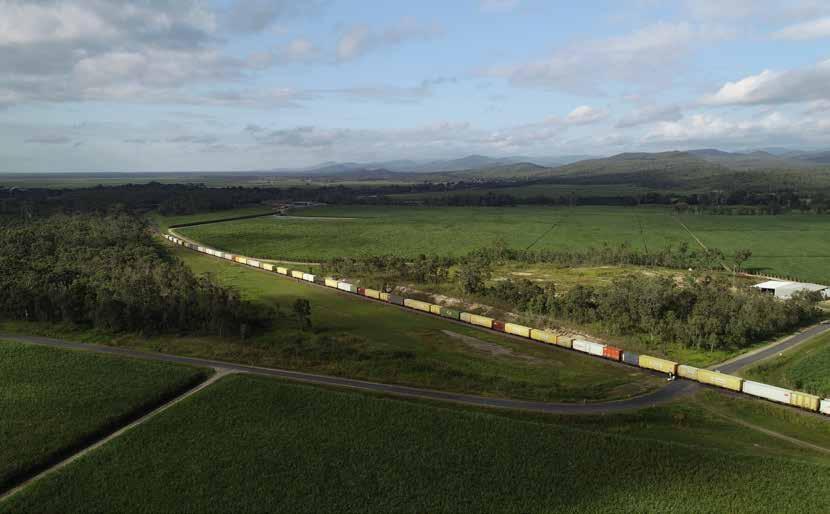

All levels of government have powers to acquire private land required for government purposes. In Queensland, the Acquisition of Land Act empowers certain constructing authorities to resume land. These authorities include the Department of Transport and Main Roads (TMR). Local Councils and some state-owned corporations such as Powerlink, Energex and Ergon are also regarded as constructing authorities with the power to resume land.
The acquisition process usually involves the following stages:
• identification of route
• giving notice of intention to resume
• objections
• t aking of land notice
• compensation – by agreement or court determination.
The process of acquisition commences once TMR has formulated a project that will involve acquisition of land. Often the proposed route will be public knowledge and interested parties such as potentially affected landholders may involve themselves in lobbying or demonstrating about the merits of the project and the proposed route.
Many TMR projects are often years in the development. In some circumstances if it is clear that certain land will be required in the future but acquisition is still some way off, then TMR may with the agreement of the potentially affected land owner purchase the land early. Such an arrangement only happens with the agreement of TMR and the land owner.
Once TMR decides to proceed, the formal acquisition commences with giving the land owner a notice of intention to resume (NIR). This notice will include details of the land proposed to be resumed.
Once the land owner receives a NIR they can reach voluntary agreement with TMR to the taking of the land if they are interested. If there is no agreement, then the land owner has a right to formally object in writing to the NIR.
The objection must be lodged within a specified time and must contain reasons for the objection. Common reasons are the need for the project, the suitability of the route, noise issues and the adverse effect on the land owner’s property.
All objections must be properly considered by TMR. TMR will then decide about the objection and must decide whether to proceed with the resumption or change the resumption in some way or discontinue it.
During the objection period there is nothing to stop affected land owners and others from lobbying the relevant Minister and the government about the proposed project.
If TMR still wishes to proceed with the resumption after considering the objections, TMR must obtain Ministerial approval. If that approval is given then through the Executive Council, the taking of the land is formally gazetted in the Government Gazette with a taking of land notice.
The taking of the land takes effect from the date of gazettal and at that time the ownership of the land resumed, changes from the land owner to TMR.
Once the land is taken by publication in the gazette a person with an interest in the land, including the owner of the land and a lessee of the land, may lodge a claim for compensation.
A compensation claim must be lodged within three years of the land being taken. As part of and in addition to the compensation entitlement, TMR will pay reasonable fees for lawyers and valuers engaged to assist the land owner in the compensation claim process to maximise the claim.
The Act and precedents from decided Court cases establish the entitlement to compensation. A major component of the compensation is the market value of the land taken at the date it was taken. There are also other costs, expenses and impacts that can be compensated.
Usually, the entitlement to compensation is based on the before and after method. What was the value of the relevant property before the land was taken and what is the value of the relevant property after the taking.
TMR will usually engage its own valuer and will make an offer of settlement usually after the land owner has lodged a claim for compensation. This offer can be accepted by the land owner if they so choose.
A prudent person seeking compensation will engage their own valuer and lawyer who can provide advice on the likely compensation entitlement. They can also advise whether the TMR offer is reasonable or whether a claim for compensation and counter-offer should be submitted to TMR.
Negotiations with TMR are common and attempts at a negotiated and agreed settlement figure for compensation usually occur. Ultimately after all negotiations have been exhausted TMR will make a final offer which is open to be accepted by the land owner.
If the final TMR offer is not acceptable to the land owner and if agreement cannot be reached on a compensation figure then either TMR or the person claiming compensation can apply to the Land Court to have the compensation entitlement determined in Court.
Court proceedings can be stressful, expensive and uncertain in outcome so taking a compensation claim dispute to Court for determination needs careful consideration.
After a claim for compensation is made, a request for an advance payment can be made to TMR. Usually, TMR will make an advancement if requested and will usually be in an amount of TMR’s offer of compensation.
The acceptance of an advance payment does not restrict or prejudice the making of an additional claim for compensation. The advance payment allows the person to receive some compensation early on whilst they proceed with making their full claim.
Any CANEGROWERS member wishing to discuss any aspect of legal matters should contact their local CANEGROWERS district office or call me on Free Call 1800 177 159 for free initial legal advice.
article contains general advice only. The particular facts and circumstances of each case always need to be taken into account)

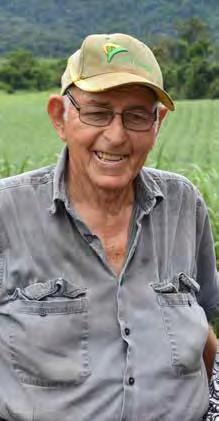
Well known Nerada grower and contract harvester Alex Gattera sadly passed away in September, Alex was featured in the 2021 May edition of the Australian Canegrower.

A firm believer in best practice farming and an early adopter of new technologies, Alex saw many changes in the harvesting sector during his five decades of cutting cane. Over the past six decades Alex built up a large cane-growing enterprise, which he operated with wife Teresa and son Wayne.
The Gattera family definitely has sound credentials, with Alex winning a Landcare award almost 20 years ago for contouring work he'd undertaken across the farm to prevent erosion, as well as revegetation and riparian work with the local council. The family are strong supporters of the Smartcane BMP program, actively participating early on in the program's roll out, gaining accreditation for their farming practices in 2016.
Alex was a respected member of the CANEGROWERS Innisfail community and thoughts go to his immediate family Teresa, Wayne and Catherine as well as his friends and colleagues.
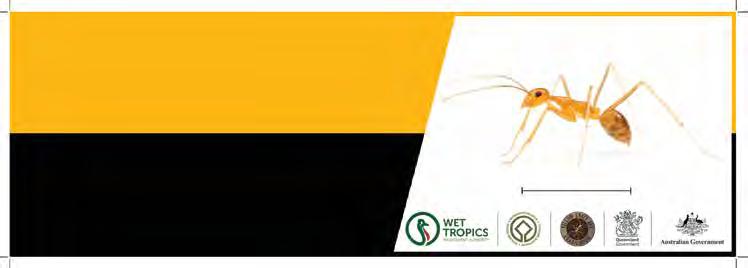
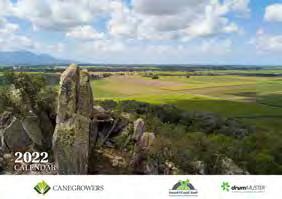
Have you got that perfect shot for the CANEGROWERS calendar? Are you an enthusiastic photographer or do you know one?
are seeking great photos that showcase what happens on a sugarcane farm throughout the year for the 2023 CANEGROWERS calendar?
It might be an early morning harvest shot, a sunny day in the paddock, finishing work at dusk, you know the shot you want to send in so let your creativity soar. Please send your photos to info@canegrowers.com.au
snapping!


WTW is proud to announce the launch of Nitrogen Risk Insurance, the world’s first parametric insurance solution for the sugarcane industry, backed by Liberty International Underwriters.
Developed by WTW and our research and development partner, CSIRO, Australia’s national science agency, the innovative insurance solution will help Queensland sugarcane farmers to cover the risk of yield shortfall from reduced applications of urea fertiliser (nitrogen) on their ratoon crops.
Urea fertiliser costs have recently doubled, with prices forecast to remain high for the foreseeable future.
Until now, sugarcane farmers have had to spend more on fertiliser or seek to reduce application rates at the risk of reducing crop yield, potentially causing even greater economic impact to their operations.
Instead of risking these losses, WTW’s unique Nitrogen Risk Insurance solution helps safeguard sugarcane farmers’ profitability.
“This new type of parametric insurance pays out faster for sugarcane farmers and is underpinned by over 20 years of sugarcane production research by CSIRO including soil, agronomy and climate data,” WTW Account Director Russell Mehmet says.
“With each policy being tailored to crop location, soil type and crop start time, farmers can insure one, some, or all of their ratoon blocks, providing complete flexibility and control over their buying decision.
"Nitrogen Risk Insurance claim payments are triggered by Bureau of Meteorology data which means the claims payment process is automated.
"Insurance assessment is not required and farmers won’t have to lodge a claim.”
The partnership with CSIRO was vitally important.
“The work CSIRO did on this solution with WTW is further evidence of the innovative way in which we continue to use our science to drive better and more sustainable outcomes for farmers and the environment,” CSIRO Chief Research Scientist Dr Peter Thorburn says.
The parametric insurance solution will result in positive environmental impacts arising from a reduction in nitrogen application.
Nitrogen fertiliser run-off to local Queensland waterways is recognised as a cause of degraded water quality on the
Great Barrier Reef, impacting its health and contributing to outbreaks of crownof-thorns starfish that cause coral cover decline.
Bill Hardie, Liberty’s Brisbane-based Crisis Management Underwriter, says he has already spoken to farmers about this product and delighted by the reaction.
Farmers can now take action against rising urea fertiliser costs to ensure their crop is protected this harvest season. Visit the Nitrogen Risk Insurance website for further information and a free quote.
For further information contact Russell Mehmet on +61 (0) 402 795 050 or Russell.Mehmet@wtwco.com
Only
Kubota B1600 4WD Int Row Spray Tank, 2 New Front Tyres & Pump $6000; 6T Newt Bulk Fert Bin $4500; Kubota L1500DT 4WD 4in1 Bucket Slasher/Back Blade/Single Tyne Ripper $8000 (all + GST) Ph: 0402686714. V8 Perkins Engine out of MF 201 Cane Harvester. 2x 18.4-30 Tractor Tyres (off Harvester). Price Neg. Ph: 0427103997 or 0740611607.
Fiat 980 2WD-3,500hrs, Fiat 1000 2WD – 5,000hrs, John Deere 4040 2WD –3,600hrs, Chamberlain JD 4080 2 WD – 5,000hrs,Case 2590 2WD – 5,700hrs, Michigan 110-14 Elevator Scraper-New engine & Spare engine, Massey Ferguson 3635 4WD – 5,500hrs, 6 tonne tipper bin, Silvan Euro Spand CX2 Spreader, Portable bulk bin, Bunning Lowlander Mk 40-60 Ag Spreader(near new), complete tracks to suit cane harvester, half tracks to suit cane harvester, and fuel trailer tank. Mulgrave area. Ph: 0407160673.
Toft 6000, CAT 3306DI, Rotary Chop, Bent elevator, standard topper. Good condition for age. Ph: 0740675327.
2x Ian Ritchie 6t side tippers. VGC. Ph: 0740562063.
Bonel billet planter. Hydraulic lock in pins. Good condition. $6,500. Ph: 0407117281. 7000 Westhill half track $2000 ONO. Ph: 0448055047.
Chamberlain C6100: very good condition, enclosed ROPS cab, Perkins 6354 engine, high-flow hydraulic pump, draw bar, good tyres. $6,000+ GST. FARM IMPLEMENTS: various including: Double-row ratoon grubbers with arch; Hodge 4-furrow reversible plough; McLeod 3-row frame. Ph for prices: 0417612883. Yeoman ripper, 11 leg frame, currently set up with 7 legs but sold with 4 spares. Ripper includes 350 dia fixed drum roller $7,900 + GST. Ph: 0439752381. MF 65 Mark 2 tractor $4,000. Page slasher gearbox $400. Roller 10 ft $1,000. Patroni 3pt linkage quick hitch frame $200. Ph: 0435550737.
Massey Ferguson 8110 4-wheel drive with cab, 135hp, only 2,636 hours in good condition. $55,000 incl. GST. Ph: 0438606578.
12t self-propelled 6x6 elev infielder. VGC. Mackay. Ph: 0438606578.
6t side tipper on Leyland tandem. GC. Mackay. Ph: 0438606578.
exclusively
etc. Advertisements from non-
ads will be accepted.
Don Mizzi 741 model on Fiat 750 special turbo plus MF102 half-tracks to suit. Mackay. Ph: 0438606578.
Celli Tiger spike hoe, 2.5m wide with hydraulic crumble roller and oil cooler. VGC. Mackay. Ph: 0438606578.
6t side tipper Ian Ritchie, Excellent condition $15,000 + GST. Ph: 0478719294.
HBM billet planter set up for dual row or single. $10,000 + GST. Twin 2.5 tonne billet planter tipper bin, carries 5 tonne $5,000 +GST. Ph: 0413584728.
2019 John Deere 6175R,175 hp, 4WD, IVT Transmission, Starfire 6000 JD GPS, Front/ Cab suspension, Premium lights, 4 electric remotes, Front weights. 3600 hrs. UHF. Immac condition. Ph: 0419641518.
Double five tonne side tipper on load sharing hitch with or without tractor. Ph: 0418379253.
Landplane or box plane, blade min. 9ft wide. Ph or txt Jason: 0422056343.

3 or 5 tyne Heavy duty 3 PL ripper to suit 150HP Tractor. Ph Terry: 0408774307.

Nissan Patrol 4x4 ute 4.2 or 3.0 ltr diesel. Have motor & gear box. Proserpine area. Ph: 0407412848.
Havester or Bin hauler job/truck work/ farm work wanted in Mossman/Port douglas area. Local and can work any hours. Email Ian on 20toughtonka@gmail.com
Motivated worker looking for work on farm as cane carter or learn the ropes for cane farming caretaker. Located Calen but can travel to surrounds. Ph Natalie: 0409195057.
Seeking truck work, farm hand or haul-out work in the Innisfail area. Holds HC, forklift & loader licences with 6 years’ experience and own transport. Ph Paul: 0423455989.
Cane farm 87 hectares - 215 acres at Como Road on Trebonne Creek, 5 minutes from
the Ingham CBD. Includes a two-bedroom cottage and farm shed. Contact Felix Reitano Real Estate on (07) 47765007 or felix@reitano.com.au
70ha Cane Farm with 61.5ha under cane.
8 km from town centre and 1 km from Victoria Mill. Property is flood free with town water supply running along property front. Paddocks have all been lasered and are well maintained and up to date with new varieties. Ph: 0427912277.
farm to lease Munburra, Sunnyside or Oakenden areas. Have own equipment. Ph: 0408011983.
840 meters opposite Moore Park Beach. Coastal Cane Farm 93 Acres and 146 megalitres of ground water. Large storage Shed. 1 x Diesel Irrigation pump for the underground irrigation. There are 2 fenced off areas, currently used for horses and cattle. No house on this property. Comes with crop. Ph Larry: 0418496864.
DEERAL Cane Farm for Sale. 52.9ha on 2 titles. Only 45mins to CBD. Peaceful location, close to panoramic river, boat ramp & mountain views. 186 Ross Road, Deeral. Ph: 0412968434.
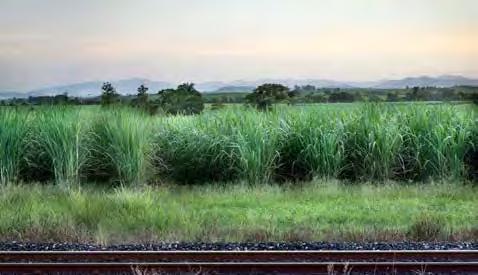
Pleystowe cane farm. On 2 Lots. Approx 190 acres all up. Teemburra water, 2 pumps & licences, plus 32,000 gallons an hour underground bore. Machinery/irrigation shed. 2x 4" soft hose irrigators, farm lasered, underground main throughout. 2 sidings adjoin farms. Access to farm from Pleystowe School Rd & Formosa's Rd. Does not include 2021 crop. Selling due to health reasons. Ph: 0408733793.
Wanting to buy/lease cane farm. Close to Racecourse mill, Tekowai, Alexandra areas. Ph: 0438545251.
Want to buy farm in the Mackay or Proserpine area. Must have two good condition houses and irrigation. Ph Paul: 0447545550.
WTB: Grazing & Irrigation Property. Grazing to run 300-500 head. 100 - 200acres irrigation. Located Sarina-Proserpine Regions. Ph James: 0429621145. Wanting to lease - cane farm in the Walkerston/Eton/Pleystowe areas and surrounds. Ph: 0421520331. Young grower wanting to expand. Looking for farms to lease. Mulgrave Area. Ph: 0431036229.
Location
Recorded rainfall (mm) Average rainfall (mm) Month prior (Aug 2022) Month to date (1 Sep-26 Sep) Year to date Jan–Sep
Whyanbeel Valley (Mossman) 96.8 44.6 2570.8 2395
Mareeba Airport 0.8 30.4 761.2 682.4
Cairns Aero 13.8 25.8 1600.6 1687.7
Mt Sophia 143 32 3367 2828.4
Babinda Post Office 215.2 27.8 3638.9 3645.3
Innisfail 112 71.8 2954.8 3038.8
Tully Sugar Mill 276 75.2 3180.5 3528.8
Cardwell Marine Pde 16.8 19.4 1423.2 1751.4
Lucinda Township 20.2 25.4 1725.8 1803
Ingham Composite 38 28.5 1547 1738.7
Abergowrie Alert 0 0 324 1152.4
Townsville Aero 1 11.2 1030.6 925.6
Ayr DPI Research Stn 2.2 10.8 822.2 765.5
Proserpine Airport 8.4 13.8 1072 1147.6
Mirani Mary Street 5.6 14.8 768.1 1137.8
Mackay MO 5.6 33.2 925.6 1264.8
Plane Creek Sugar Mill 0 0 913.6 1380.2
Bundaberg Aero 11 46 978.2 715.1
Childers South 10.2 57.4 1066.6 621.7
Maryborough 11.6 47 1010.6 854.8
Tewantin RSL Park 18.2 103.8 2211.8 1239.3
Eumundi - Crescent Rd 16.6
2179 1298
Nambour DPI - Hillside 28.4 101 2526.8 1396.2
Logan City Water Treatment Plant
88.6 1364.6 816.2
Murwillumbah Bray Park 19.7 157.4 1720.1 1199.4
Ballina Airport
New Italy (Woodburn)
Brought
222.6 2502.4 1412.7
158 2272.2 1055.2





Growers have an important role in keeping watch for exotic pests, diseases and weeds that could devastate the Australian sugarcane industry.

Early detection and reporting is the key to protecting farms, industries and the communities that rely on them. Every moment lost harms our chance of successful eradication.
If you spot anything unusual in your crop please call the Exotic Plant Pest Hotline on 1800 084 881. The call is free (except from mobiles).
Visit phau.com.au/industries/sugarcane for further information and a list of the top priority cane pests.
alert,
Take your sprayer to the next level of accuracy and performance with RightSpot precision spraying technology from Ag Leader. Suitable for retrofitting to most self-propelled or trailed sprayers, RightSpot incorporates proven blended pulse technology to ensure consistent droplet size and coverage, regardless of operating speed. With instantaneous switching for up to 144 individual nozzles and automatic turn compensation, RightSpot optimises the efficacy of your spraying program and reduces input costs.



local
